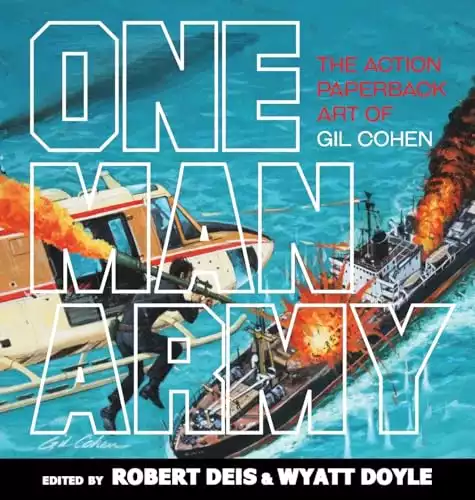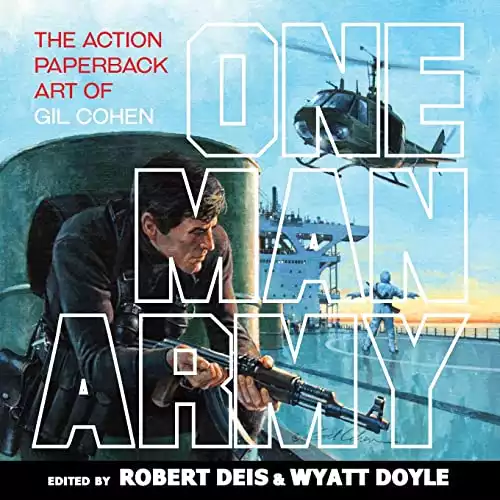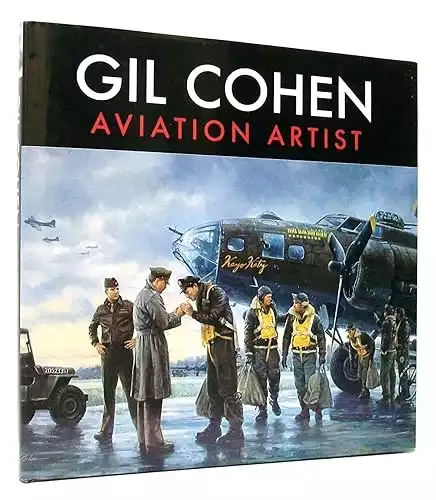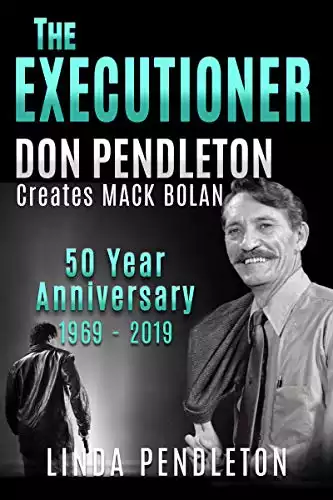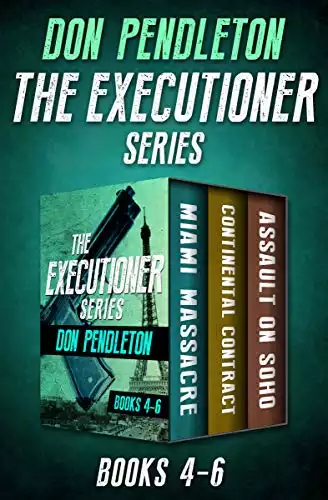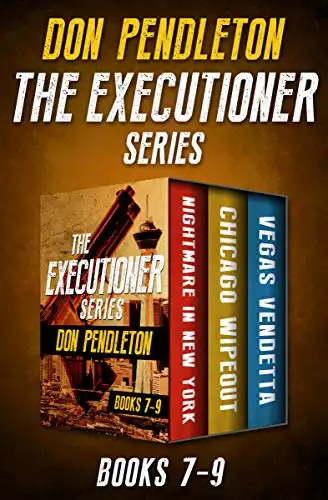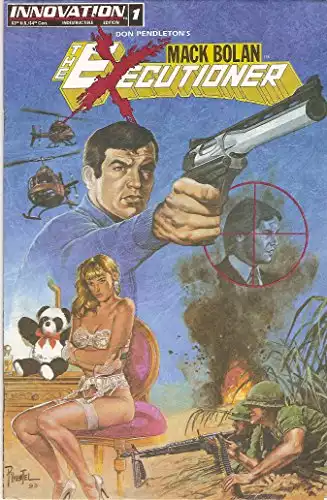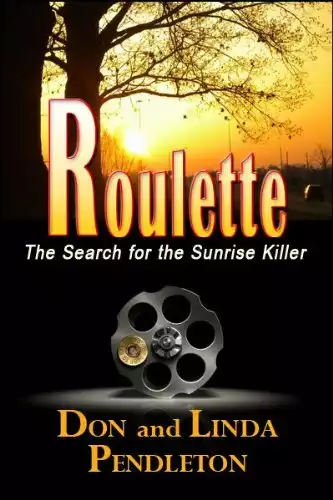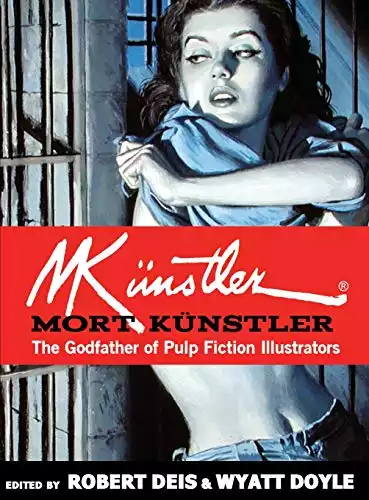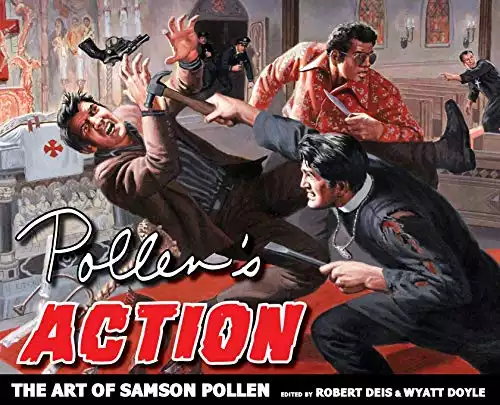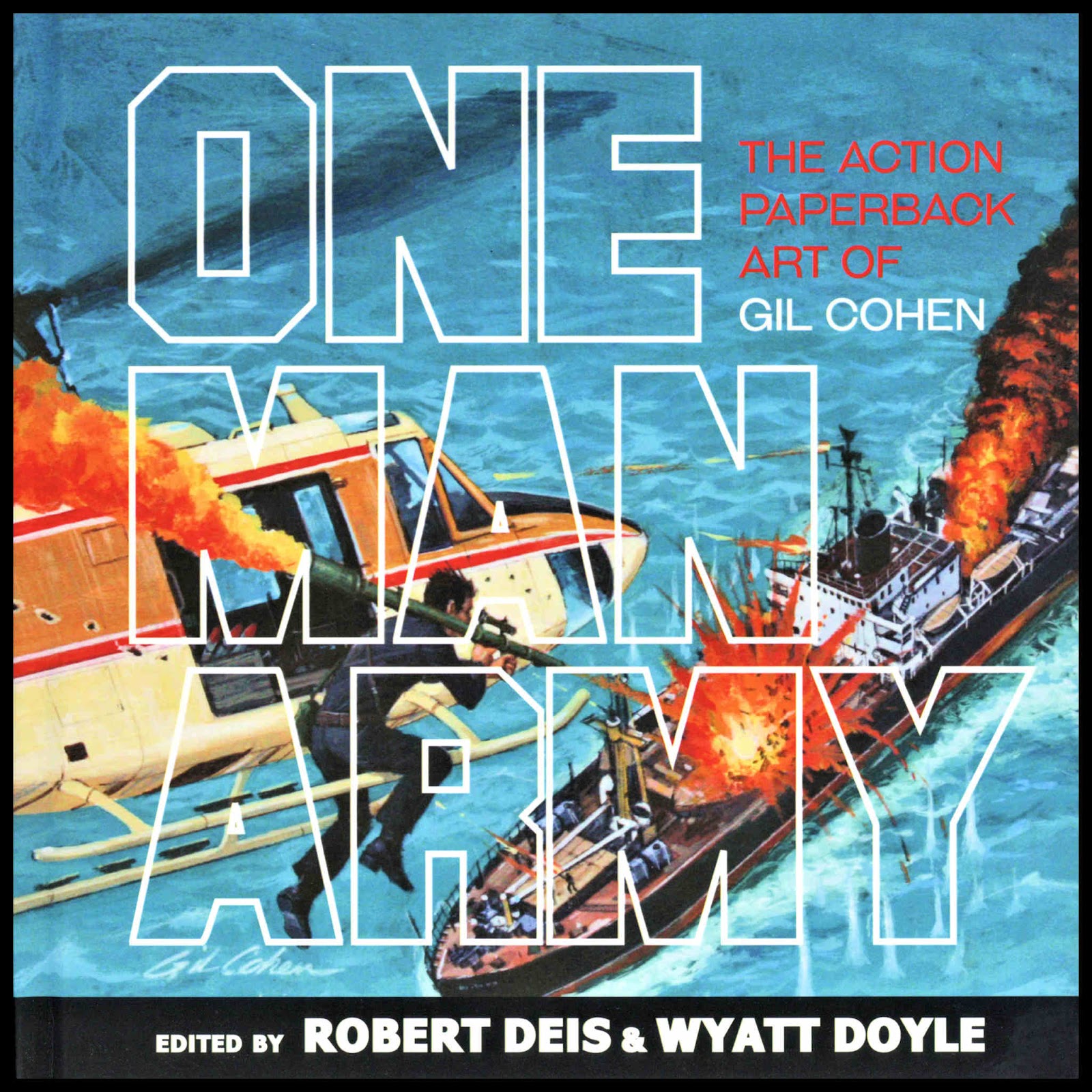
Artist Gil Cohen is one of the towering figures in several art realms.
In recent decades he has established himself as one of the world’s premier military aviation artists. His beautifully-rendered, historically accurate paintings of military planes and their crews and high end prints of them are popular with aficionados of that realm throughout the world.
Early on in his career as an artist, starting in the 1950s, Gil was one of the top cover and interior artists for men’s adventure magazines (MAMs).
Most of his MAM artwork was used for MAMs published by Martin Goodman’s Magazine Management company — the “Diamond logo” group that included ACTION FOR MEN, FOR MEN ONLY, MALE, MAN’S WORLD, MEN, STAG, and TRUE ACTION, among others.
I first met Gil via phone and email when I did an interview with him about his MAM artwork for this blog.
In that interview, we briefly touched on a third realm that Gil is known for: his paperback cover artwork. In that realm he is best known as the primary cover artist for the hugely popular novels based on Don Pendelton’s character Mack Bolan, The Executioner. He also did the initial artwork for the Mack Bolan spinoffs: the SuperBolan series, the Stony Man series, the Able Team series and the Phoenix Force series.
A couple of years ago, I did another interview with Gil about that paperback cover artwork. As a result of that conversation, I started thinking about doing a book featuring Gil’s original paintings for those books as part of the Men’s Adventure Library book series I co-edit with Wyatt Doyle, the multi-talented head of New Texture, which publishes our MAL books.
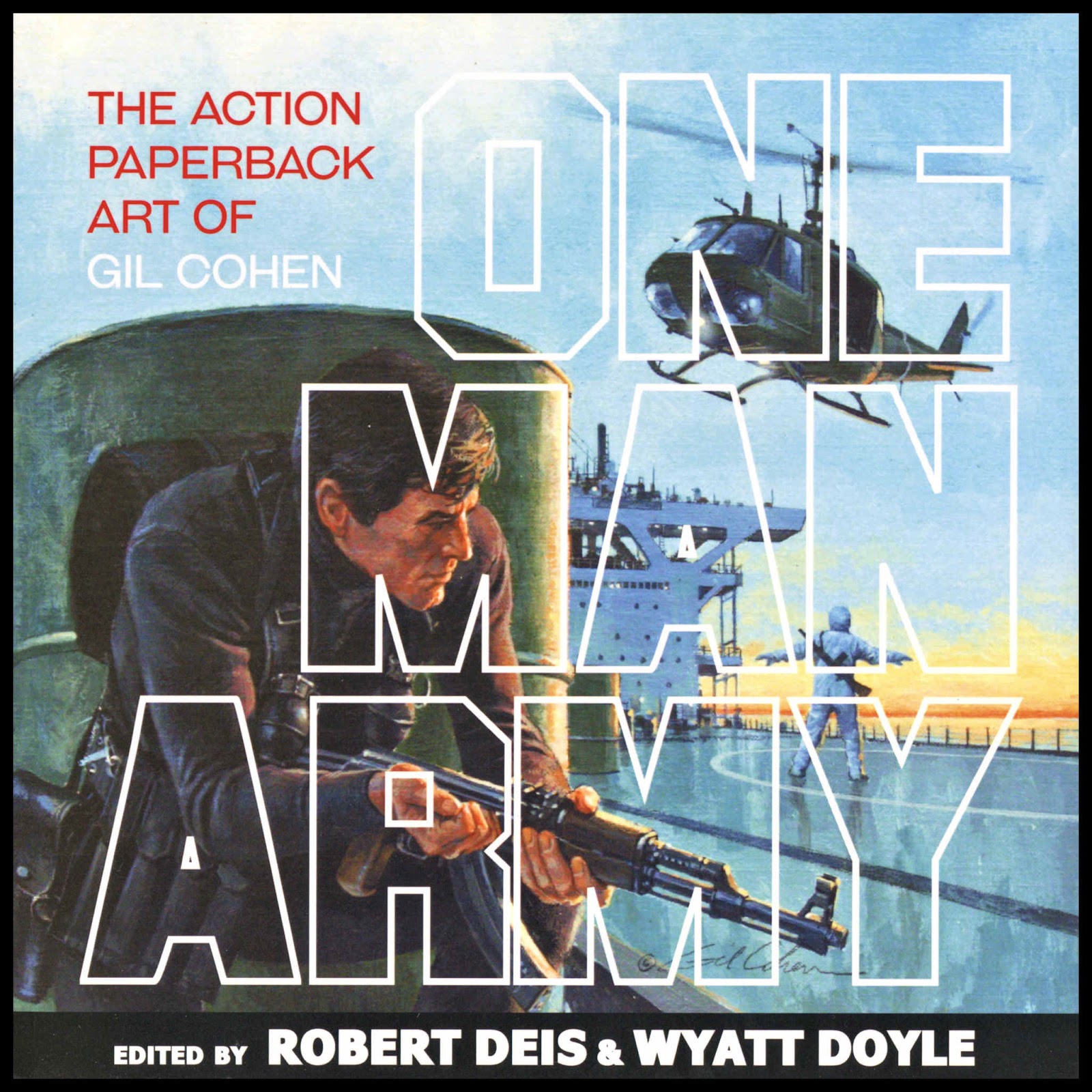 Wyatt loved the idea. Gil Cohen said “yes.” And, recently we released the book — ONE MAN ARMY: THE ACTION PAPERBACK ARTWORK OF GIL COHEN. Its title nods to both the ever-resourceful Mack Bolan as well as the astonishing productivity of Cohen himself in that era.
Wyatt loved the idea. Gil Cohen said “yes.” And, recently we released the book — ONE MAN ARMY: THE ACTION PAPERBACK ARTWORK OF GIL COHEN. Its title nods to both the ever-resourceful Mack Bolan as well as the astonishing productivity of Cohen himself in that era.
The paperback edition of ONE MAN ARMY (shown at right) showcases full color reproductions of nearly 100 of Gil’s original Executioner, SuperBolan, Stony Man, Able Team, and Phoenix Force cover paintings. The deluxe hardcover edition (at the top of this post) includes more than 100.
The book opens with a quote about Gil by Linda Pendleton. Linda is Don’s widow and a prolific author of novels and non-fiction books in her own right. She co-authored several books with Don before his death in 1995, including the first entry in the Executioner comics series, and wrote the definitive book THE EXECUTIONER, DON PENDLETON CREATES MACK BOLAN. She maintains the Official Don Pendleton Website which includes in-depth information about him, his Mack Bolan novels, and the many other types of books he wrote. Linda also frequently posts comments in the popular online hangout for Executioner fans, the Mack Bolan Facebook Group, created by Bolan superfan Ed Sunday. What Linda says about Gil in ONE MAN ARMY will ring true to any serious Mack Bolan fan:
“When I visualize Don Pendleton’s Mack Bolan, I see Bolan as Gil Cohen portrayed him on the covers of Don’s Executioner novels, and on numerous early Harlequin Executioners and spinoff series. Don loved Gil’s cover art, and I still receive comments from Executioner fans who mention how much they like Gil Cohen cover illustrations. Seventeen years of wonderful Mack Bolan cover illustrations by a very talented artist! I’m sure the scenes on the covers helped to sell books. Gil Cohen is very much a part of the Don Pendleton-Mack Bolan tradition of nearly half a century. The Executioner series would not be the same without Gil Cohen’s illustrations.” — Linda Pendleton
Linda’s insightful quote is followed by an extensive interview with Gil. In it, he talks about how he came to do cover art for the Executioner series and its descendants, his approach to the artwork, the models he used, anecdotes he remembers about specific paintings, his appearance with Don Pendleton at the 1985 Mack Bolan convention in San Francisco, and more.
As I write this post, ONE MAN ARMY is now listed for sale on Amazon in the US and worldwide, on Barnes & Noble, on the website of Stuart Ng Books, and on the Book Depository site, which offers free shipping worldwide. I also sell copies directly, signed on request, via my own listing on Amazon (as Robert Deis on the list of sellers) and my eBay listings.
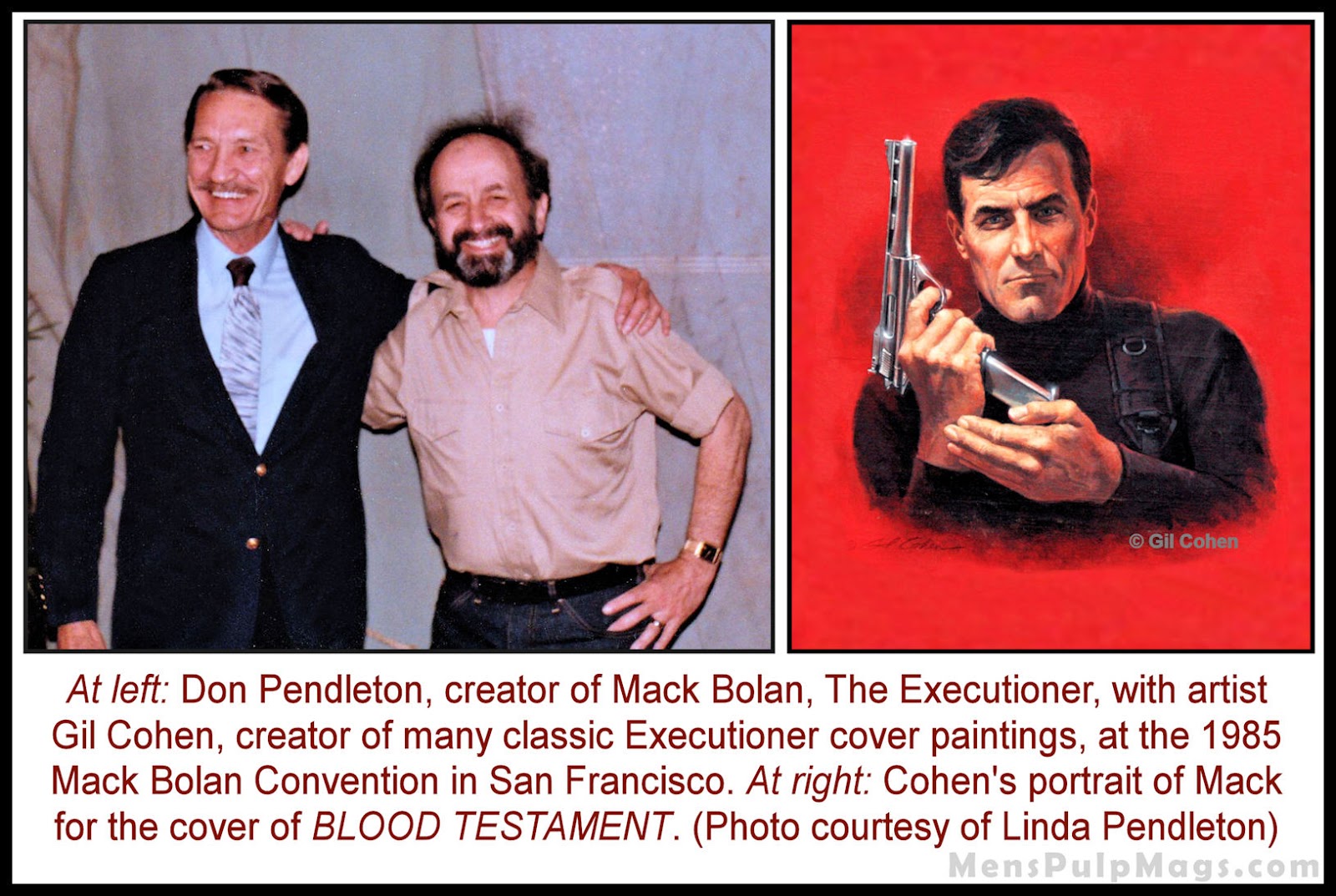
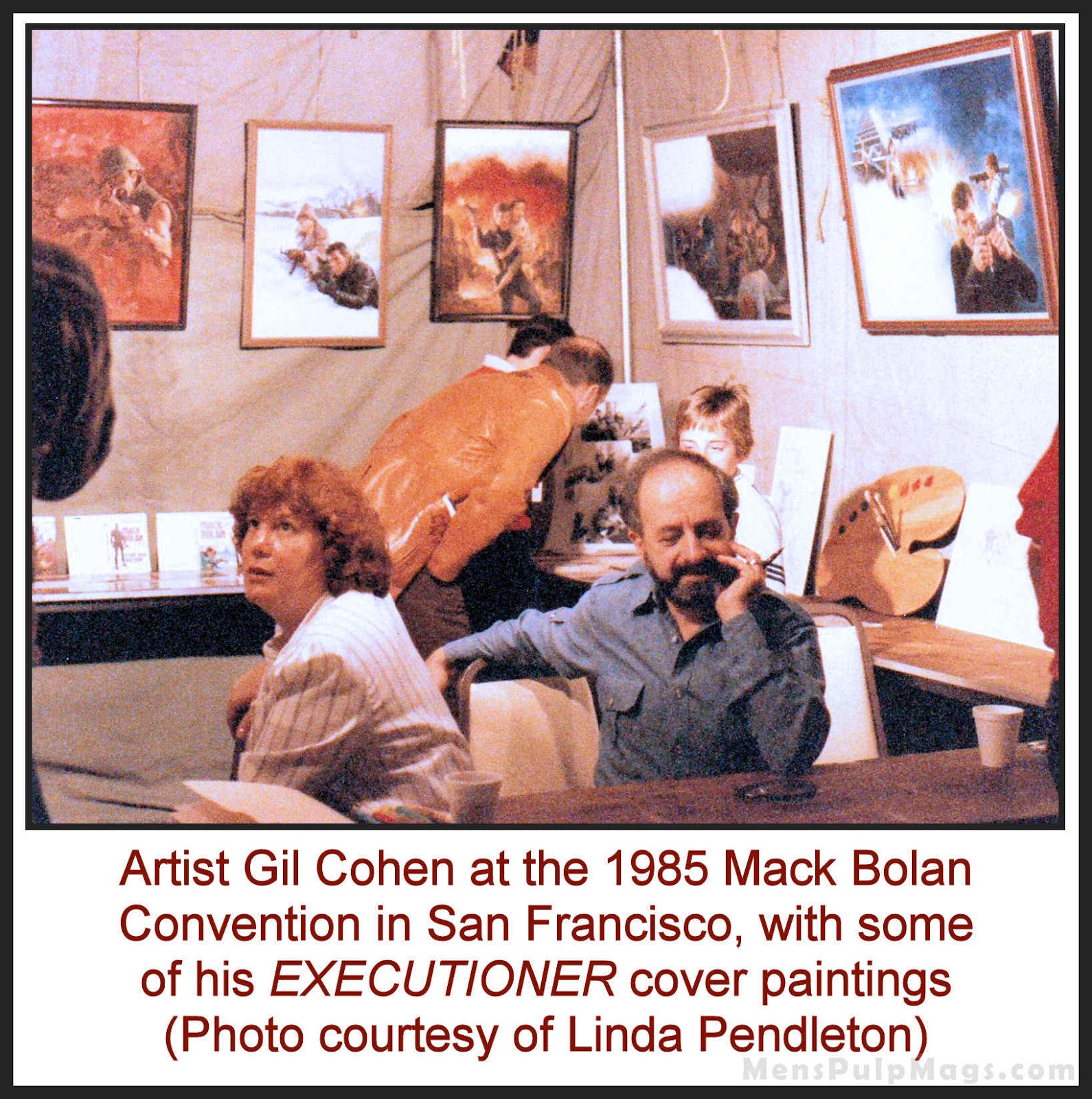
Here’s a buying tip: because the book is new, Amazon doesn’t keep a lot of copies in stock yet and there are other shark-like sellers trying to sell the book on Amazon for more than the list price. Some don’t even keep the book on hand and have to order it from another source to fill an order, causing a delay in shipment. So, at this point, if you want a copy shipped quickly and at the best price, buy direct from me. I’ll also sign a copy on request and add an inscription of your choosing.
In this post, I’ll give you a preview of the book, along with some quotes from Gil Cohen’s interview. As you’ll see, the cover paintings vary in shape. Some were intended to fit the bottom half of a standard paperback front cover. Some were painted to fit the full front cover. Some are “wraparound” paintings that are horizontal in format. The right half of those wraparounds were printed on the front of the paperback covers; the left half on the back.
As a result, the margins around each painting vary in ONE MAN ARMY, as shown by the examples in this post. They are actual page scans (with the resolution reduced and a watermark added for online posting). In the book, each painting is presented without any caption, so they stand alone as works of art. There’s an appendix in the back that tells the name of the paperback the painting on each page was used for and the year it was published.
Below is a look at the first page of our interview with Gil, which shows the first cover he did for the series, CALIFORNIA HIT. Next to that are the pages showing his original paintings for WAR AGAINST THE MAFIA and DEATH SQUAD.
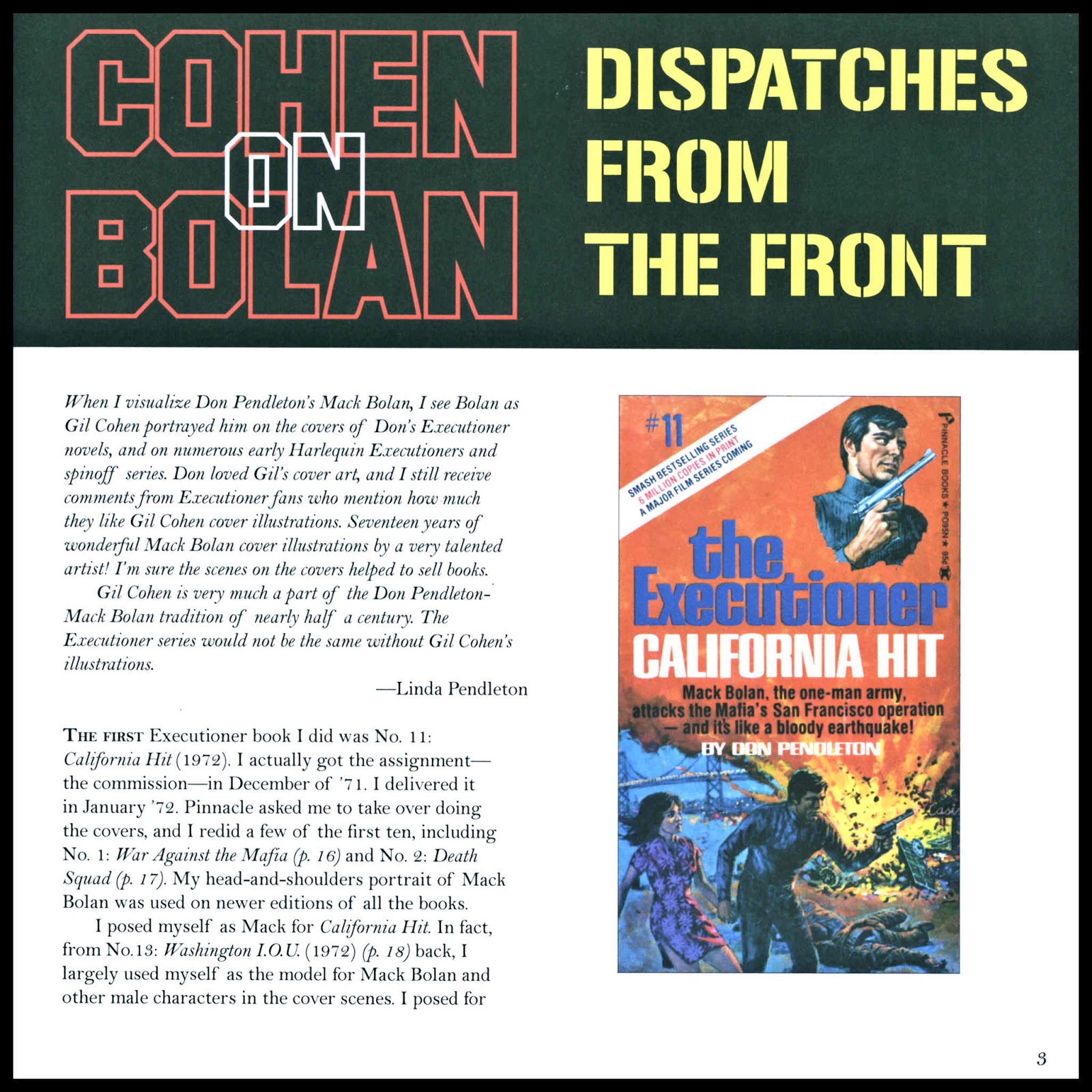
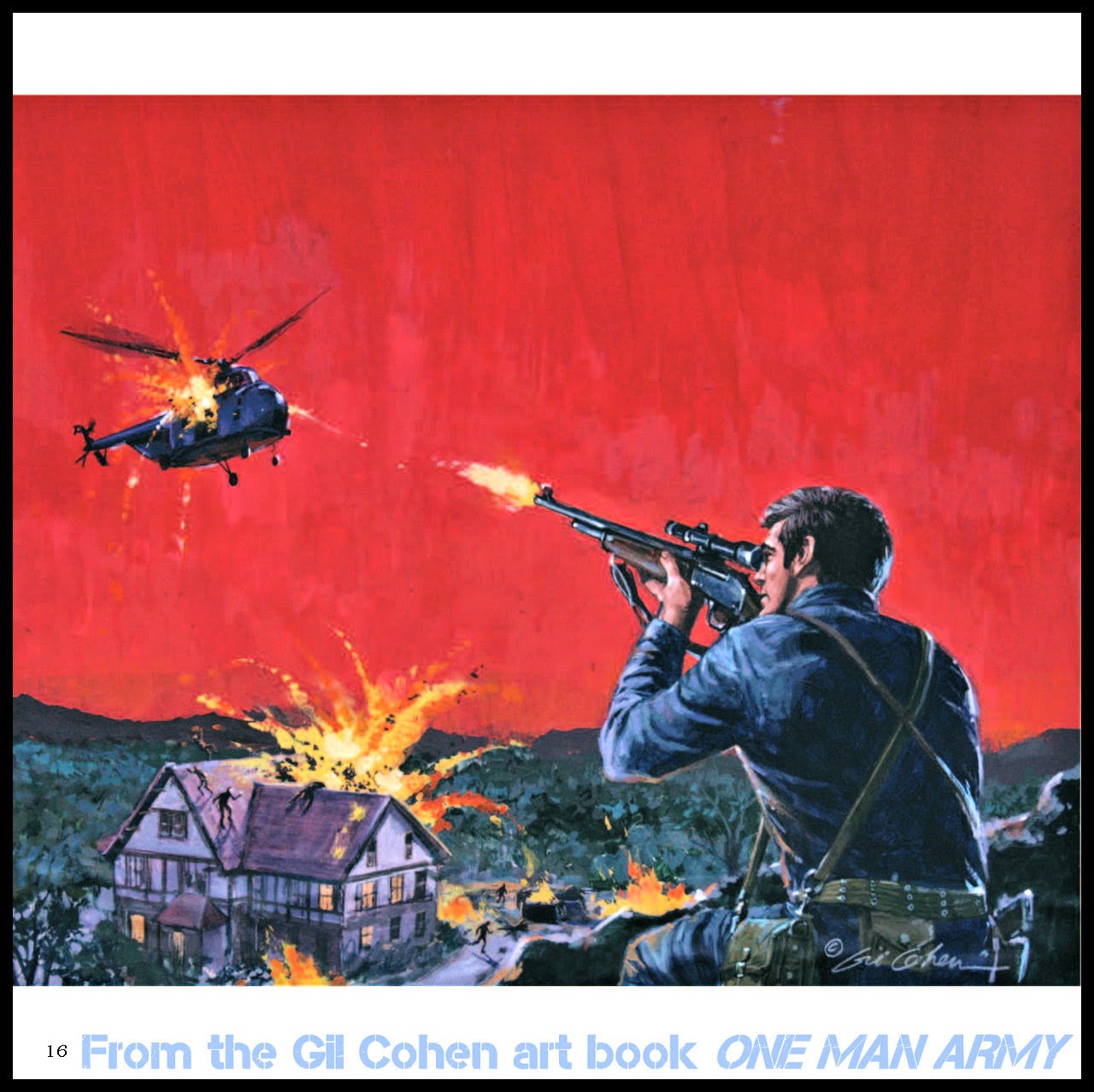
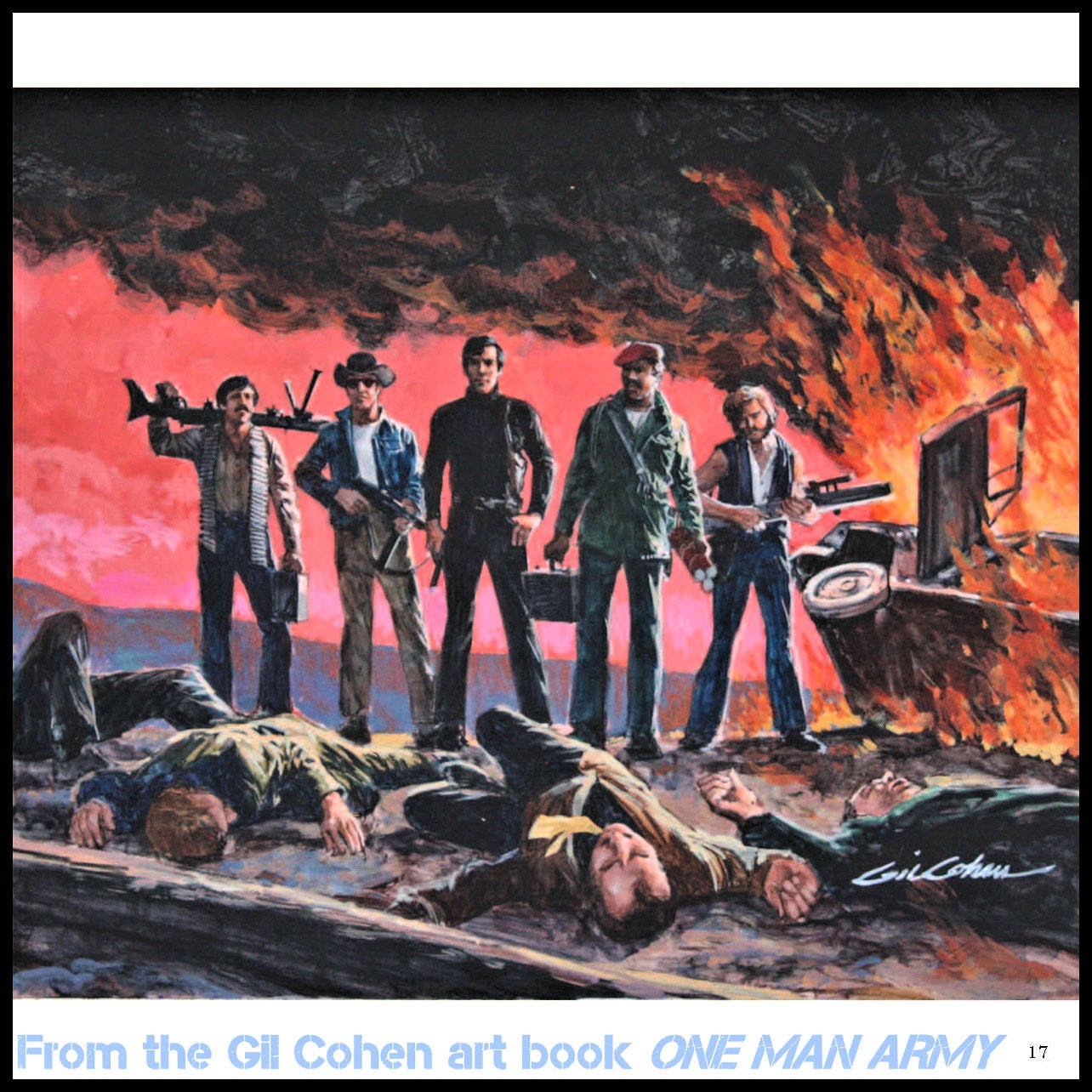
When Pinnacle Books licensed the rights to publish the Executioner series from Don Pendleton, the art department had cover paintings for the first ten books done by artist George Gross, a friend and mentor of Mort Kunstler (whose original men’s adventure magazine paintings are showcased in our book MORT KÜNSTLER: THE GODFATHER OF PULP FICTION ILLUSTRATORS).
The first editions of WAR AGAINST THE MAFIA and DEATH SQUAD were published in 1969 and were huge hits. Over the next three years, Pinnacle published eight more Executioner novels that originally had George Gross cover art. By late 1971, the original editions of the first ten Executioner novels had sold six million copies and Pinnacle turned to Gil Cohen for the cover of the next Mack Bolan novel Don Pendleton had written for the series. Gil recalls:
“The first Executioner book I did was No. 11: CALIFORNIA HIT (1972). I actually got the assignment—the commission—in December of ‘71. I delivered it in January ’72. Then Pinnacle asked me to take over doing the covers, and I was also asked to do cover paintings for new editions of the first ten in the series. So I did CALIFORNIA HIT, then I redid the first ten covers, starting with Executioner No. 1: WAR AGAINST THE MAFIA, which I delivered to Pinnacle in April of 1972. I posed myself as Mack Bolan for CALIFORNIA HIT. In fact, from No.13, WASHINGTON I.O.U. (1972) back, I largely used myself as the model for Mack Bolan and other male characters in the cover scenes. I posed for the reference photos, shot with a Polaroid camera. I could draw and turn myself into any kind of a character, and I did that a whole lot.”
Pinnacle published 38 Executioner novels between 1969 and 1980, using Gil Cohen as the cover artist. All but #16, SICILIAN SLAUGHTER (1973), were written by Don Pendleton. That one is so un-Pendleton-like that it remains a continuing source of controversy among Bolan fans. However, I do love the cover painting Gil did for it. It’s in the middle below, in between his paintings for #13, WASHINGTON I.O.U. (1972) and #24, CANADIAN CRISIS (1975) on the right.
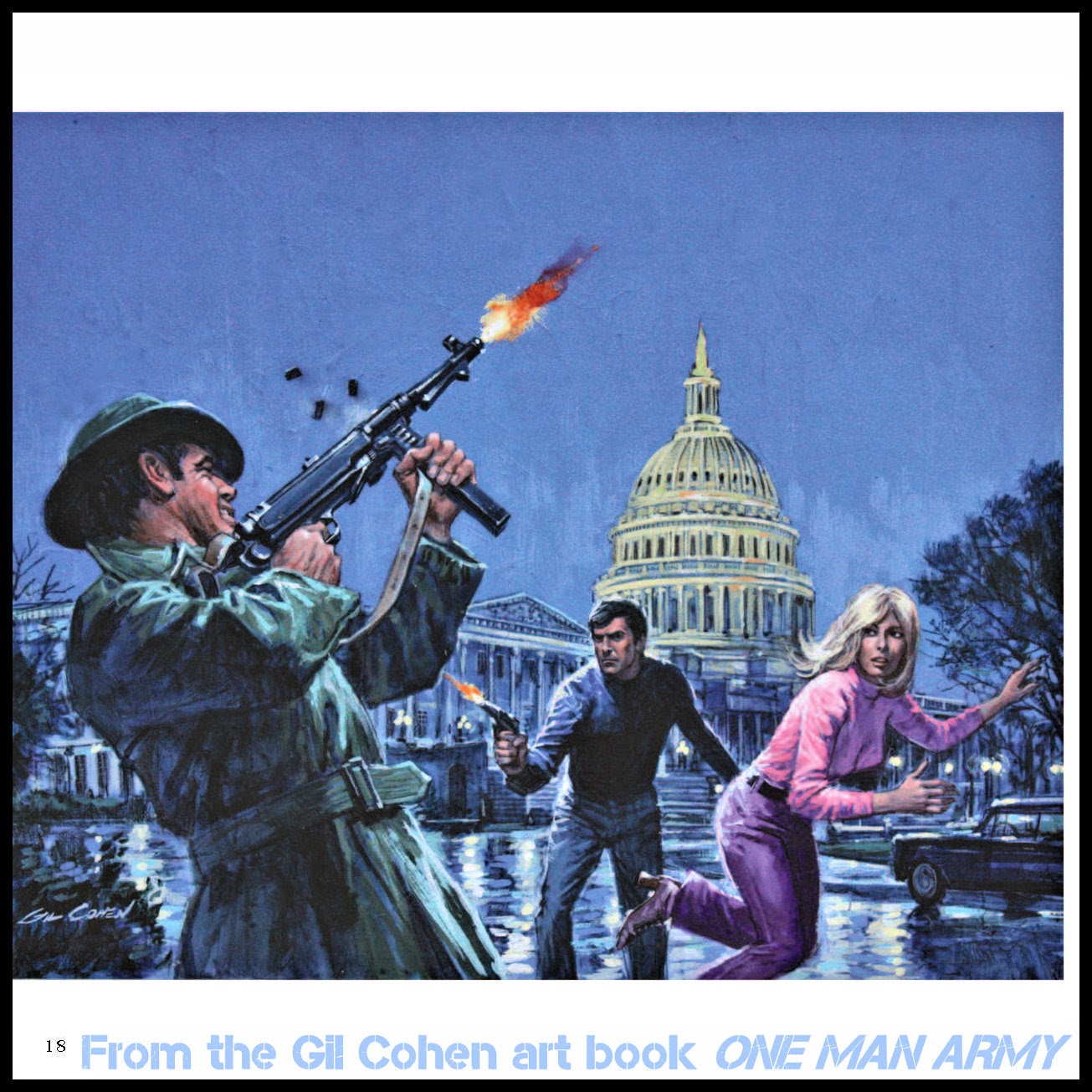

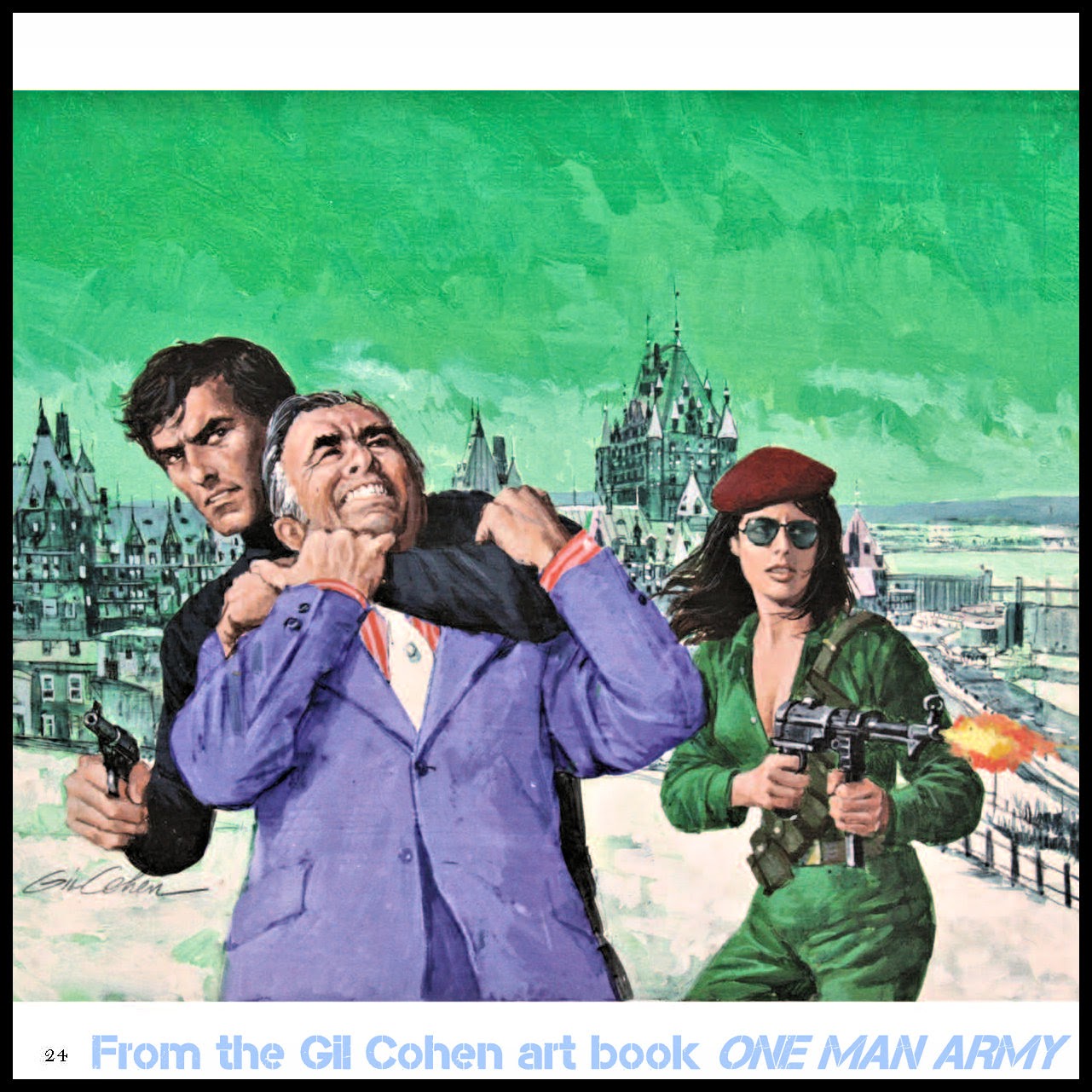
During the years when Don Pendleton was writing the Executioner novels, Gil Cohen created some of his most classic Mack Bolan covers. Here are some more examples from that era in our book: #31, ARIZONA AMBUSH (1977), #32, TENNESSEE SMASH (1978) and #37, FRIDAYS FEAST (1979), which we picked for the cover of the deluxe hardcover edition of ONE MAN ARMY.
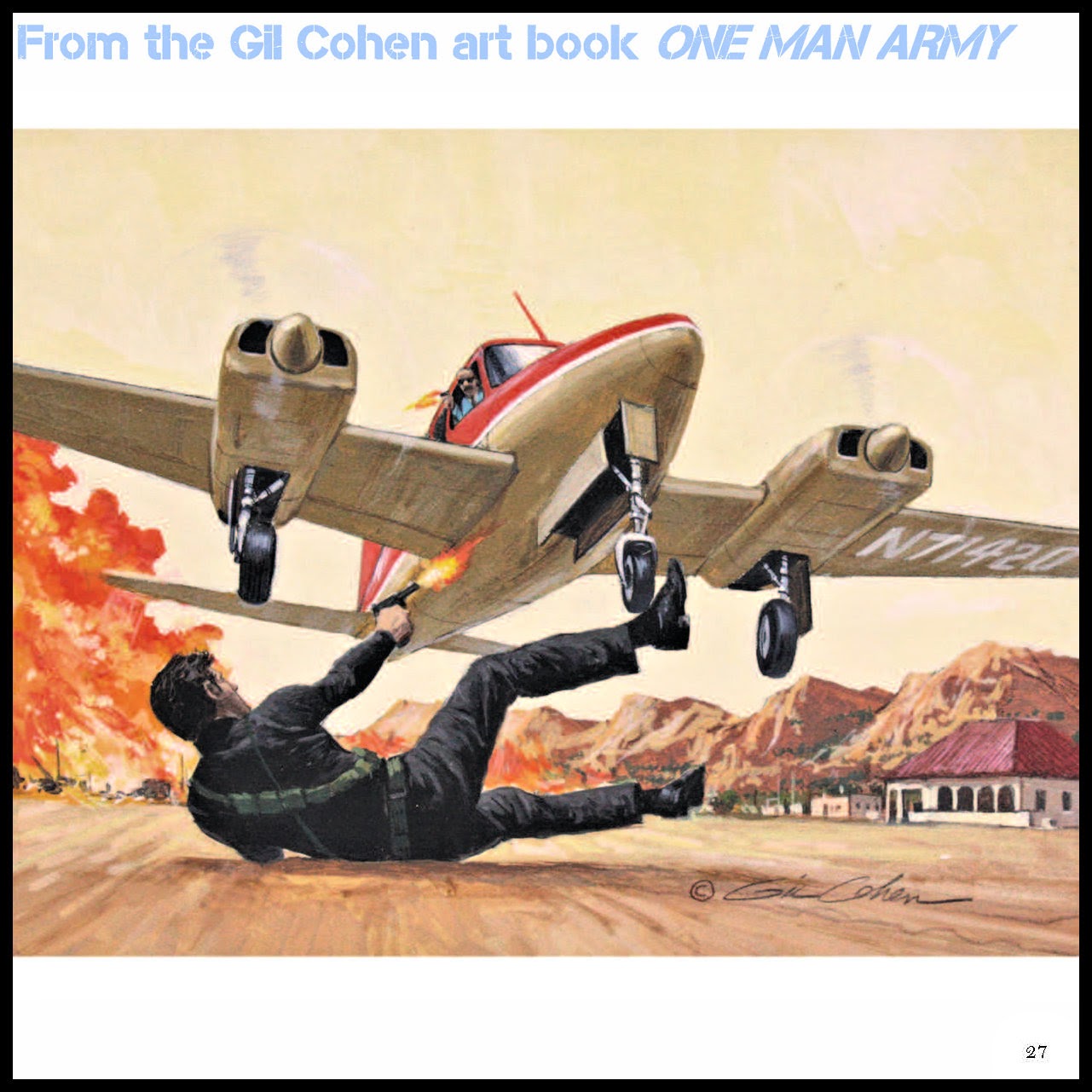
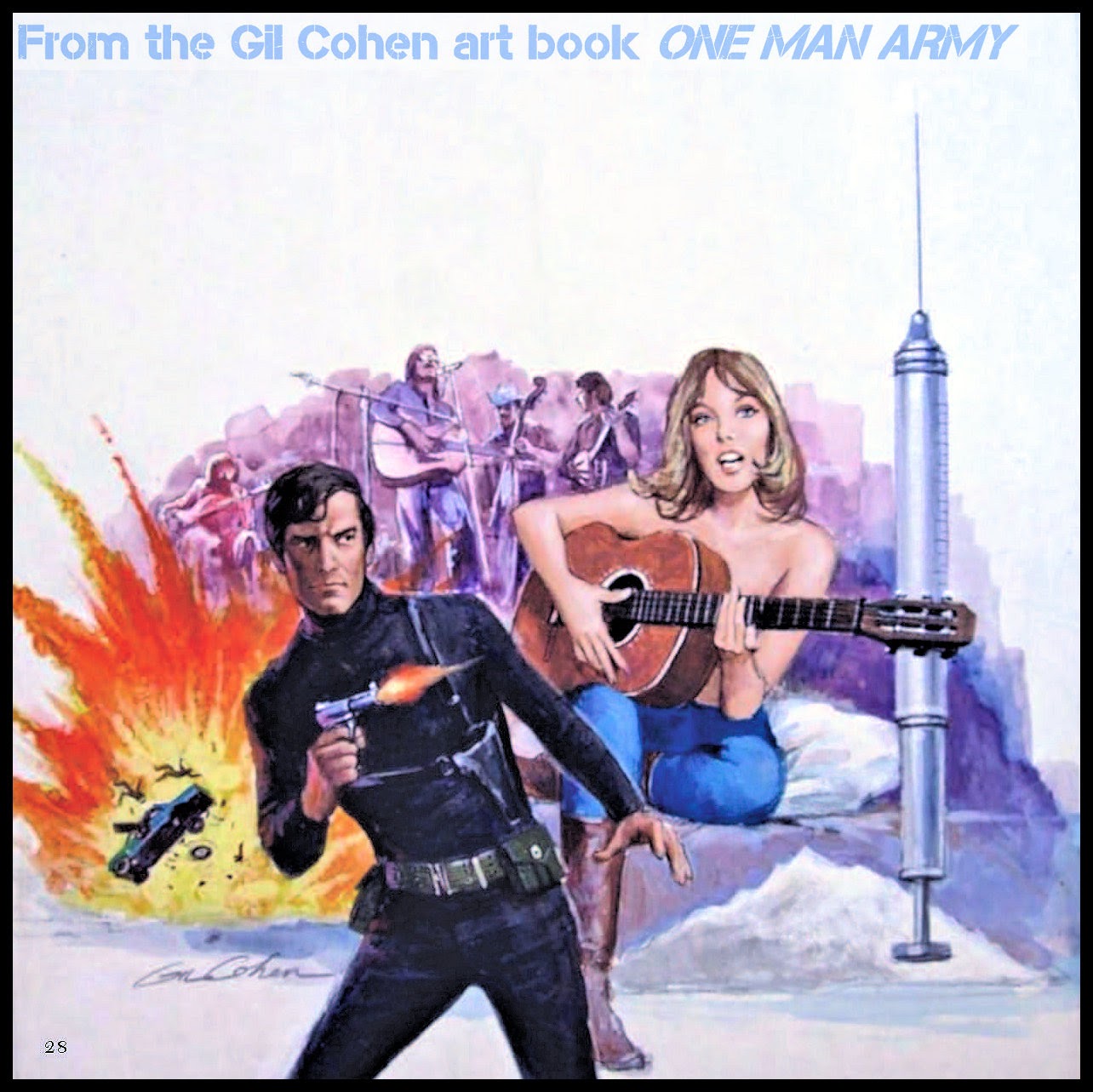

In 1980, Don Pendleton licensed the rights to the Executioner character to Harlequin’s Gold Eagle subsidiary, which is still publishing Mack Bolan novels under the Don Pendleton House name and is up to more than 450 books in the series. Harlequin tapped a number of talented writers to continue the series, such as Stephen Mertz, Michael Newton, and Dan Schmidt, and its fan base continued to grow. Harlequin’s art director wisely chose Gil Cohen to continue doing the cover art for the Bolan novels — and eventually for the Executioner spinoffs, the SuperBolan, Stony Man, Able Team, and Phoenix Force novel series.
Although many of Gil’s early Executioner covers are fan favorites and created the Mack Bolan image, his cover art during the Gold Eagle era just kept getting better and better. Below are three of my faves from the early ‘80s included in our book: #43, RETURN TO VIETNAM (1982), #46, BLOODSPORT and #56, ISLAND DEATHTRAP (1982).
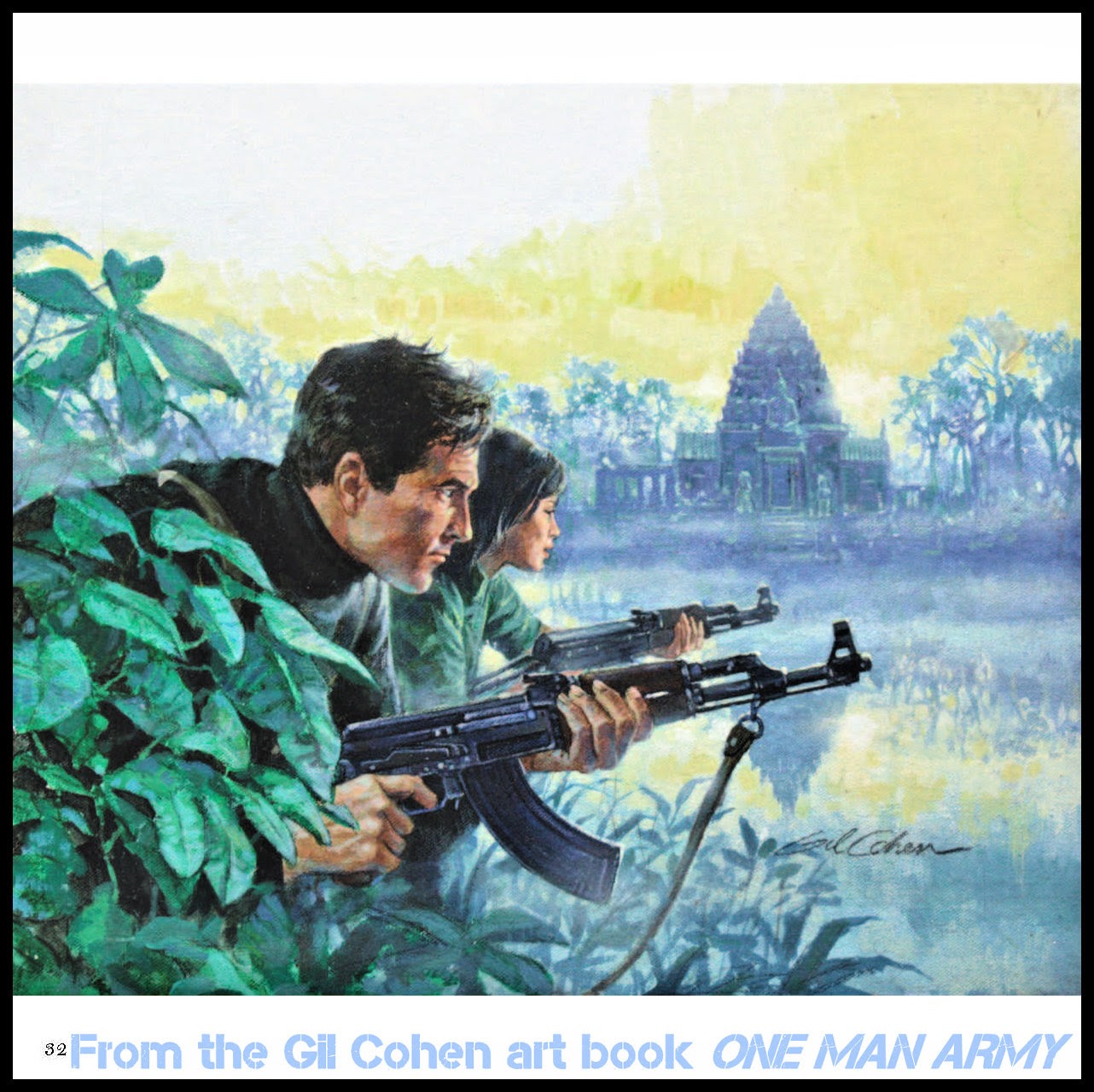
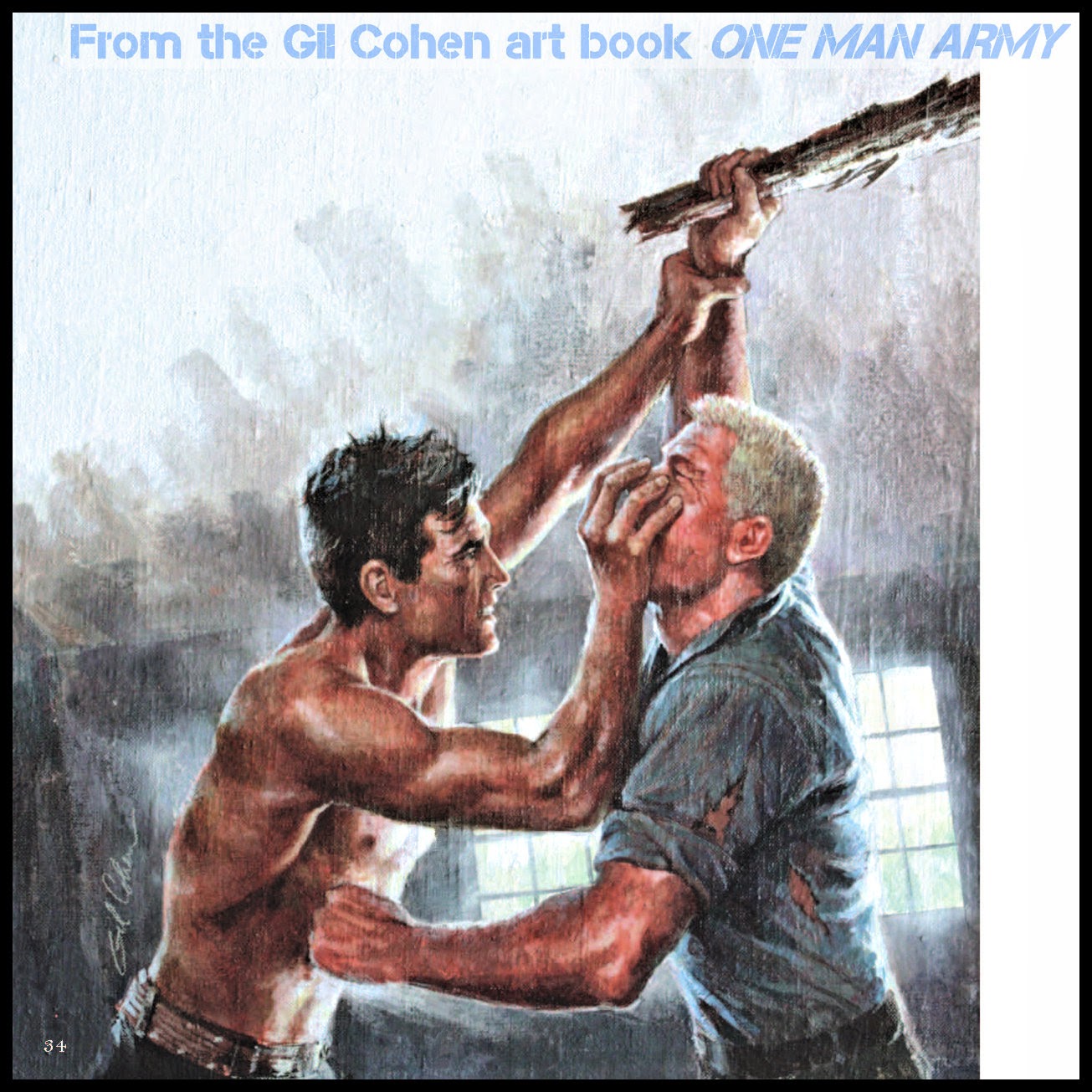
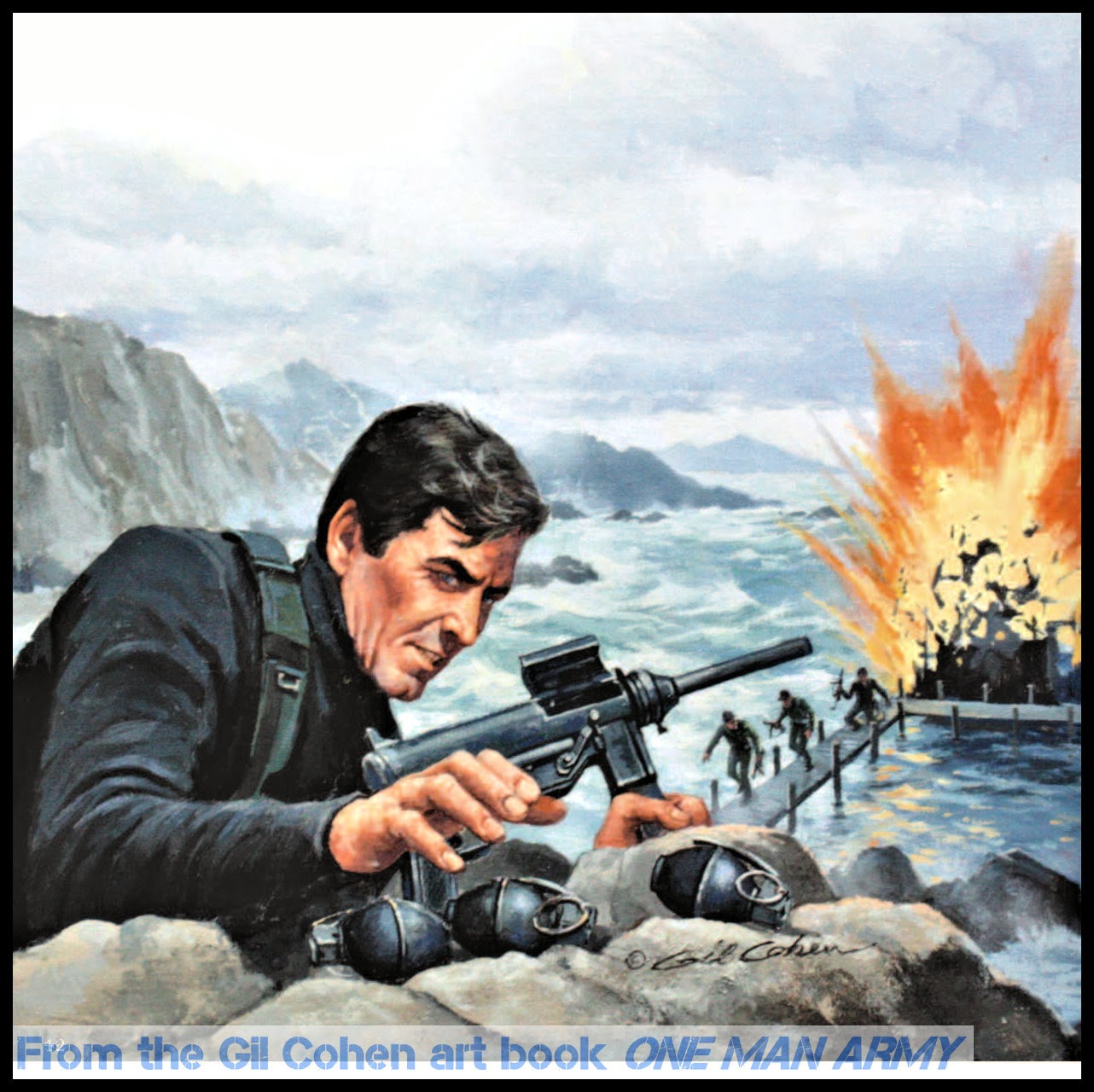
One of the interesting anecdotes Gil tells in the book is about Executioner #60, SOLD FOR SLAUGHTER. The page with his original painting for that one is shown below, in between his originals for #59, CRUDE KILL (1983) — which we picked as the cover art for the paperback edition of ONE MAN ARMY — and #63, THE NEW WAR BOOK (1984).
Regarding SOLD FOR SLAUGHTER. Gil told us:
“Mack is holding a kind of special machine gun that looks like something that I made up, but it existed: a Hawk MM-1 MGL Automatic Grenade Launcher. It had a huge barrel, where you had an array of different bullets and missiles and stuff that could come out of the different chambers. Now you can’t just get that kind of weapon anywhere legally; even if you had a Class 3 license. I tried to get one for my reference photo and couldn’t. So, I figured, in order to get Mack—played by my brother-in-law Robby—to hold it properly, I’ve got to kind of make a mockup of that gun. So I did. I got tubes, I got a pistol grip from a model of a .45 handgun…it took a lot of work. But I did it, and I was really proud of it. I posed Robby holding it, and I thought it would impress the fans. Well, I brought those reference photos to the Mack Bolan Convention in San Francisco in 1985. Fans were looking at them, and one says, ‘What the hell is this? I expected you to have the real thing.’ They were disappointed! I was proud of the model I had done, but these guys were disappointed. They expected the real gun, and thought Robby had been holding the real deal for the painting.”
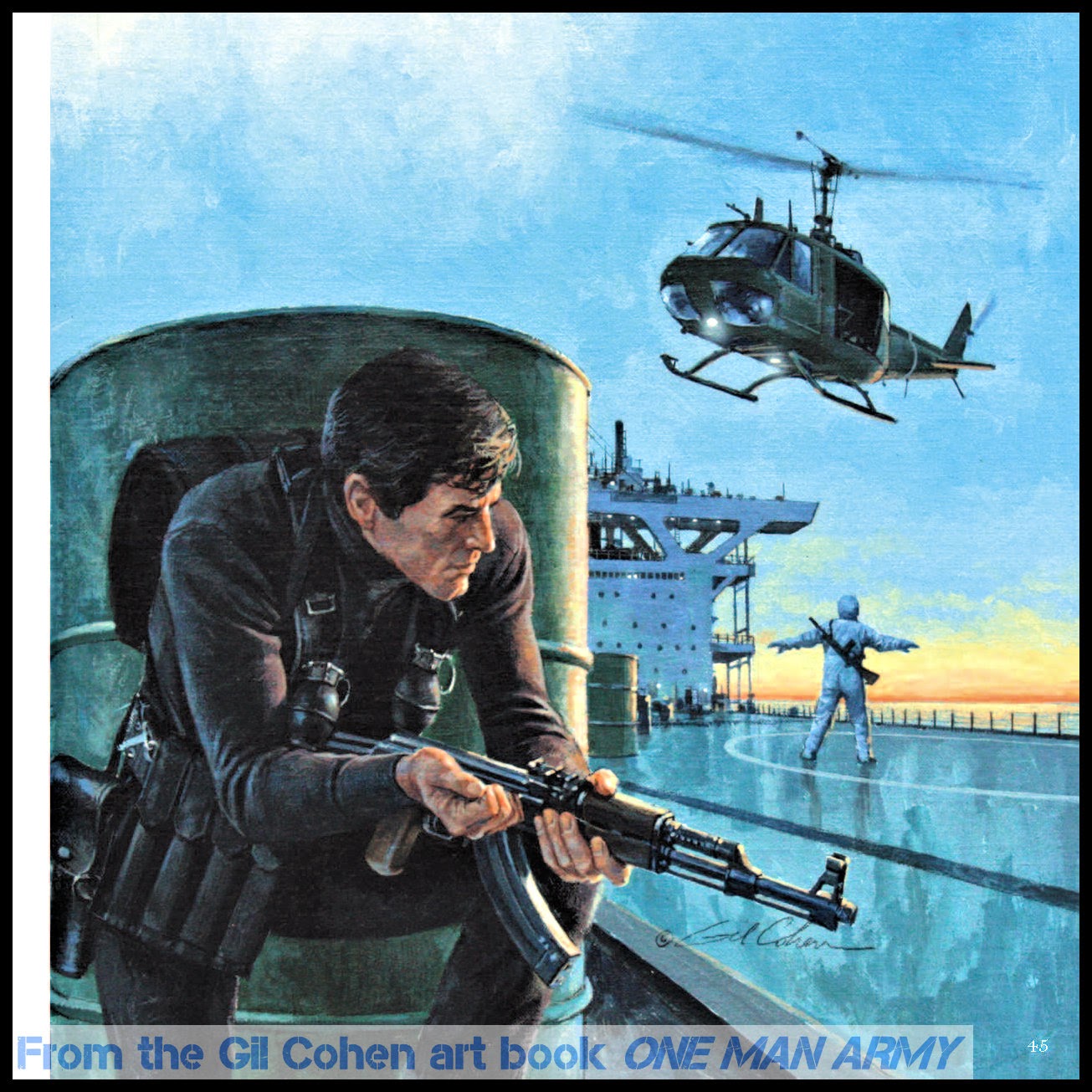
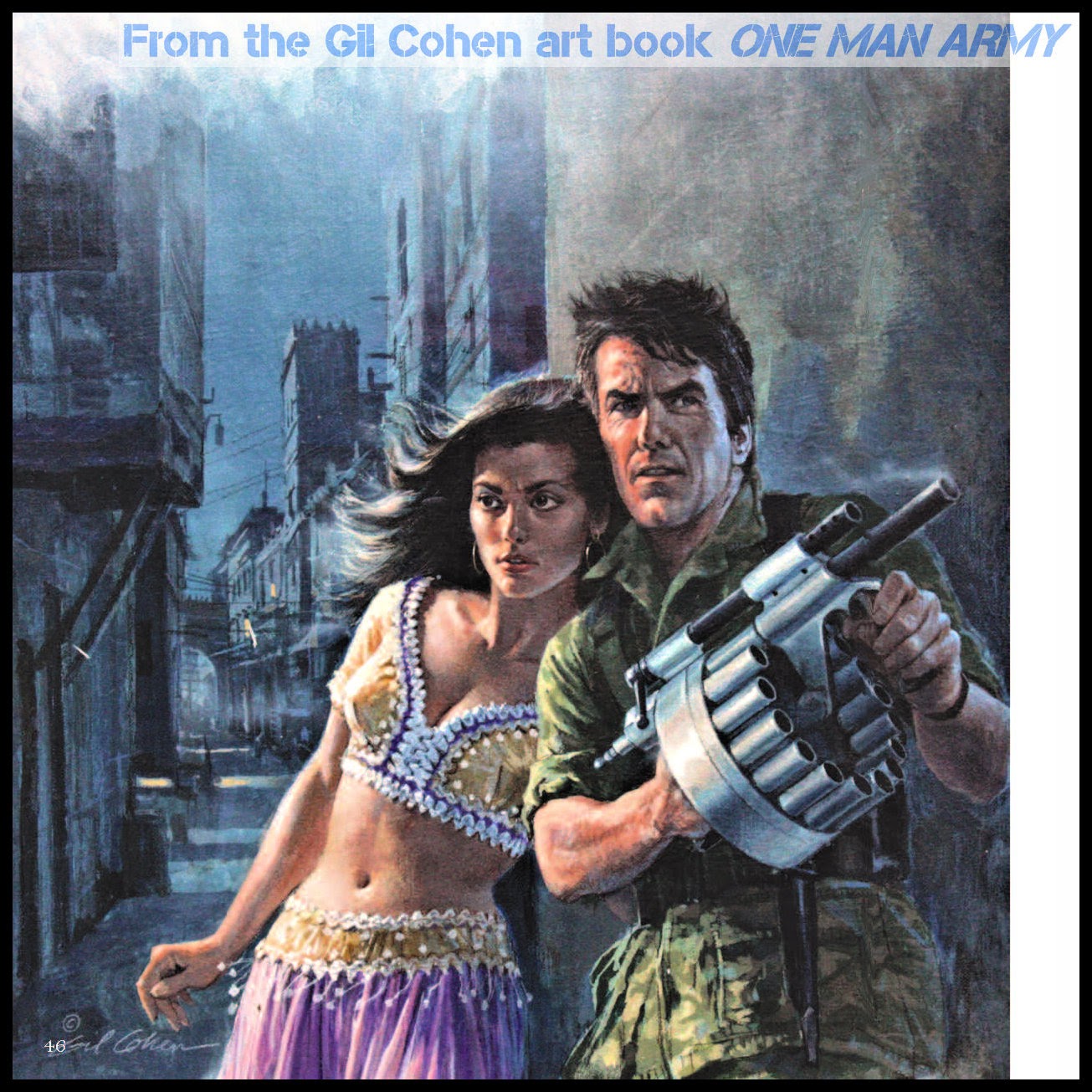
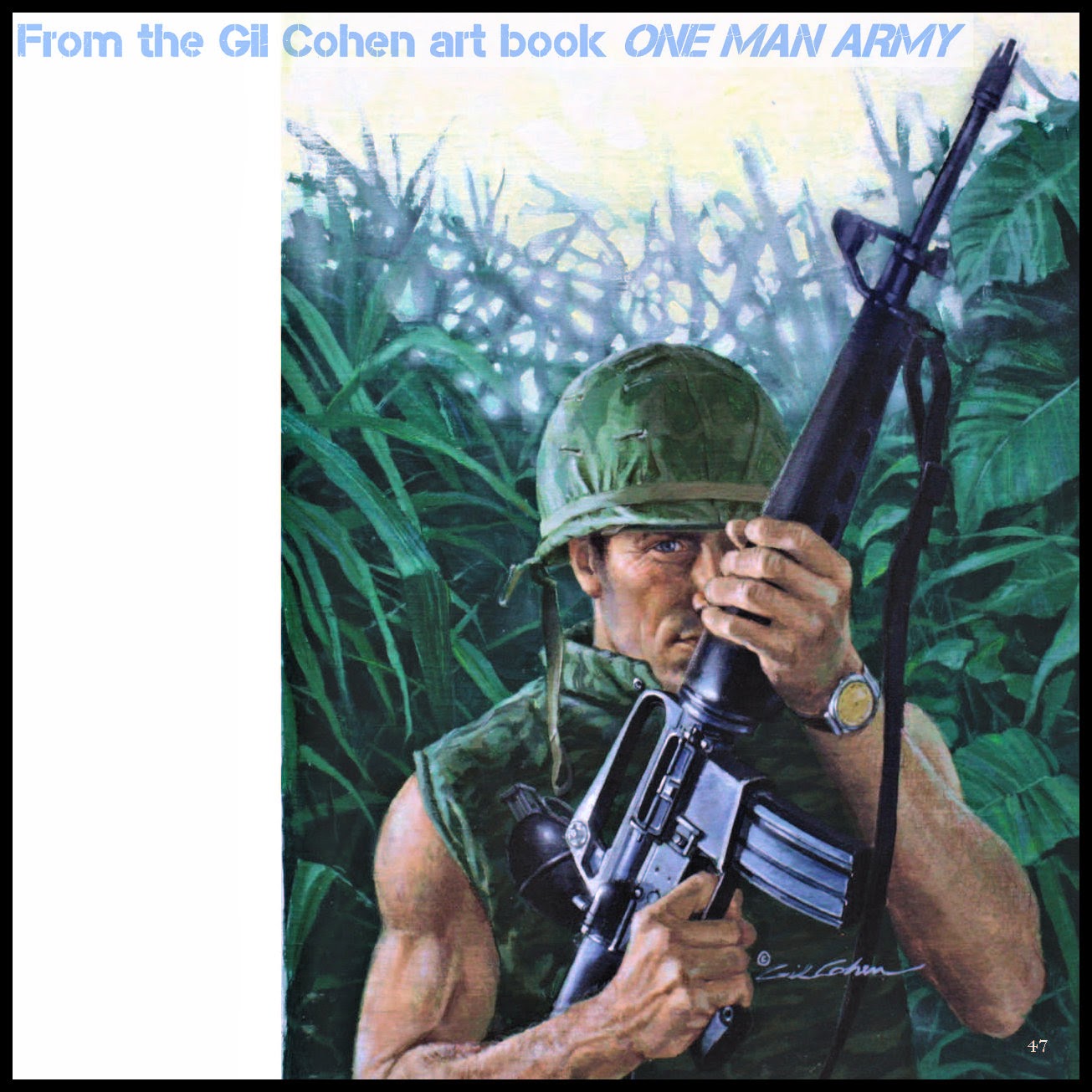
Harlequin kept Gil very busy through the 1980s producing cover art for Gold Eagle paperbacks. He recalls:
“After [Harlequin Art Director] Charles Kadin commissioned me to do the Executioner covers and spinoffs for Harlequin, Harlequin was without doubt my most important client for over ten years. They were giving me so much work, I hardly had the time to work for anybody else. I was doing one Mack Bolan every month. I was doing one Phoenix Force. And for several years, I was also doing one Able Team cover every month. That’s a hell of a lot of artwork! So, overwhelmingly, Harlequin was my main client from about 1981 until the early ’90s.”
Here are some pages from the book showing Gil’s original Executioner cover paintings from the mid-1980s that are favorites of mine and many other fans: #80, RUNNING HOT (1985), #91, THE TRIAL (1986) and #100, BLOOD TESTAMENT (1987).
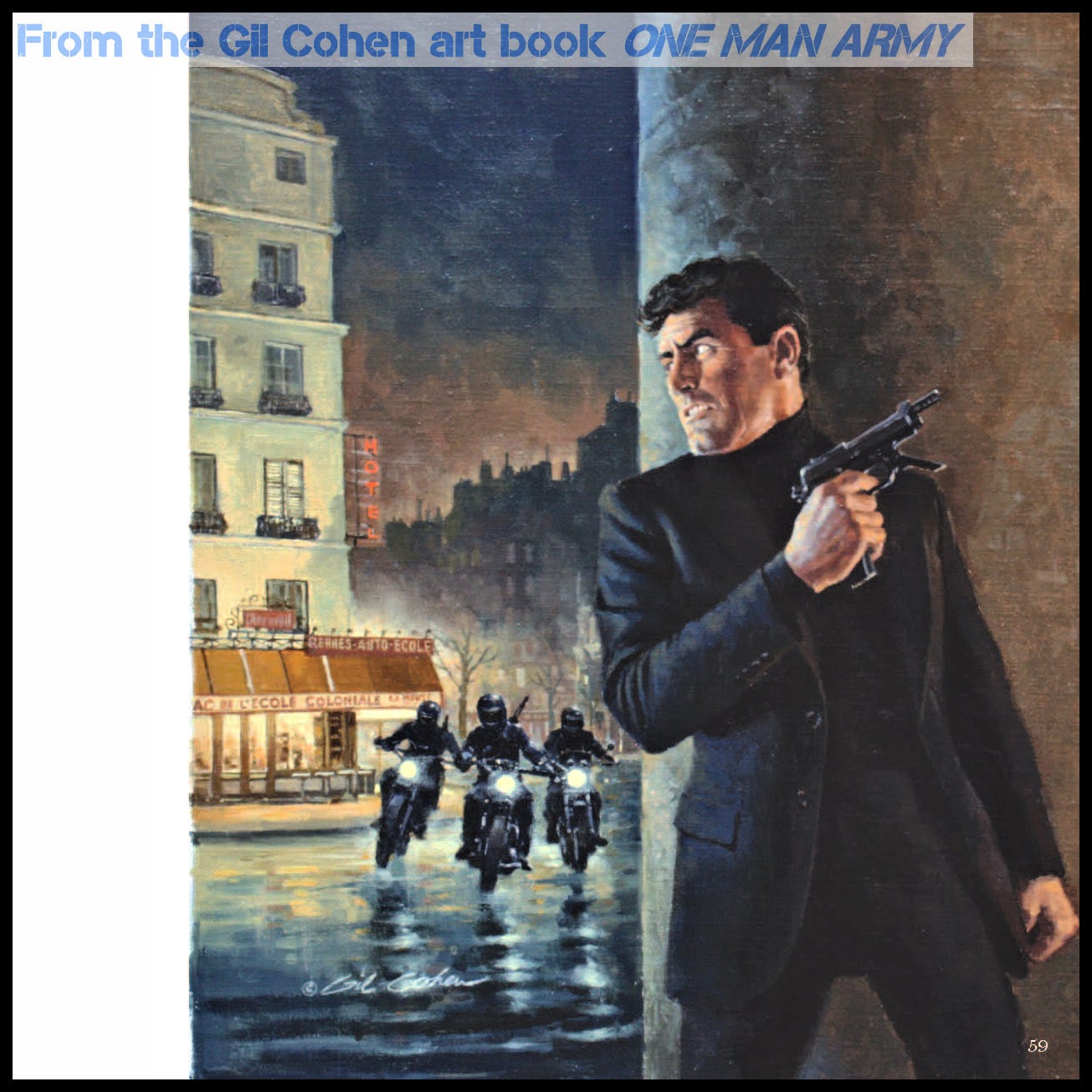
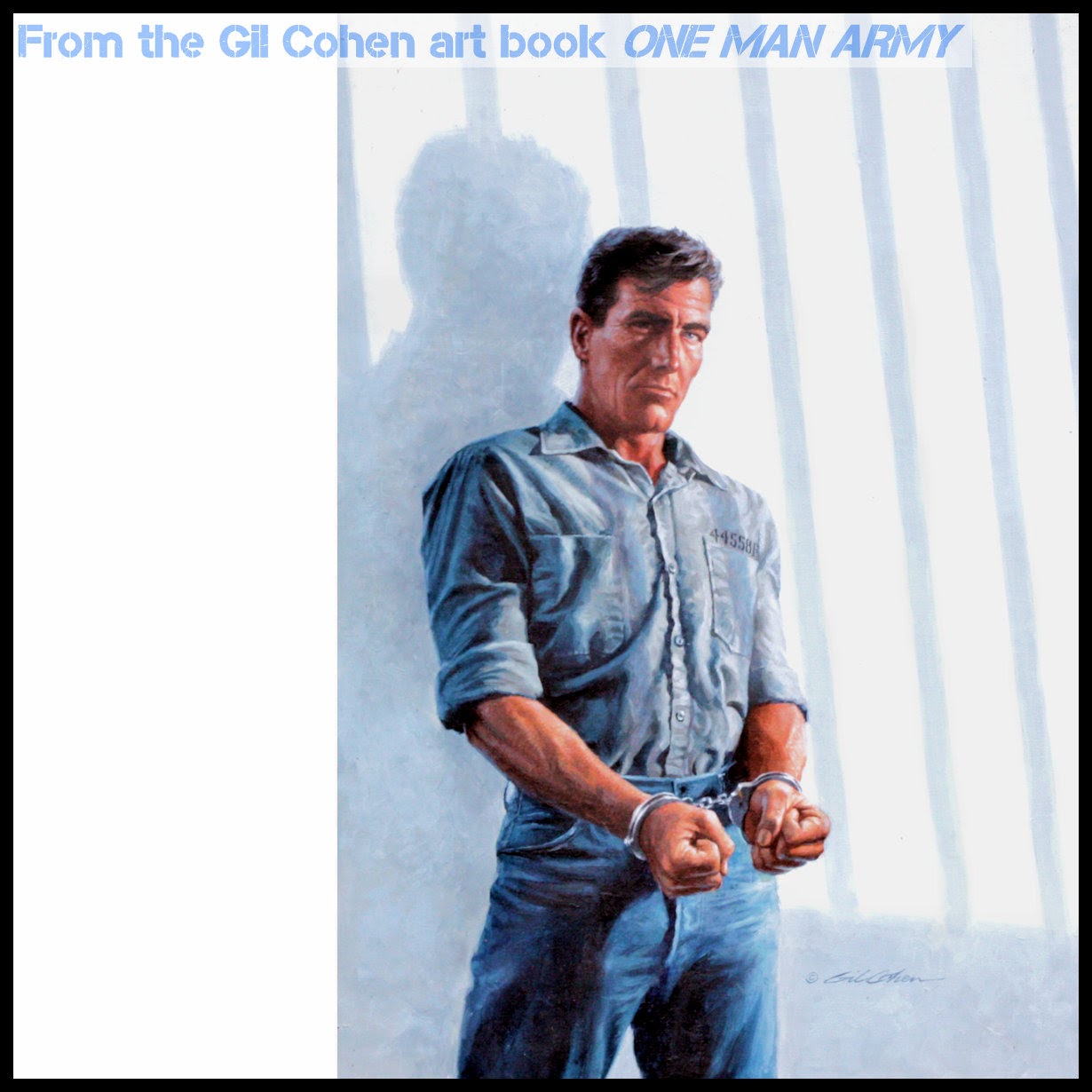
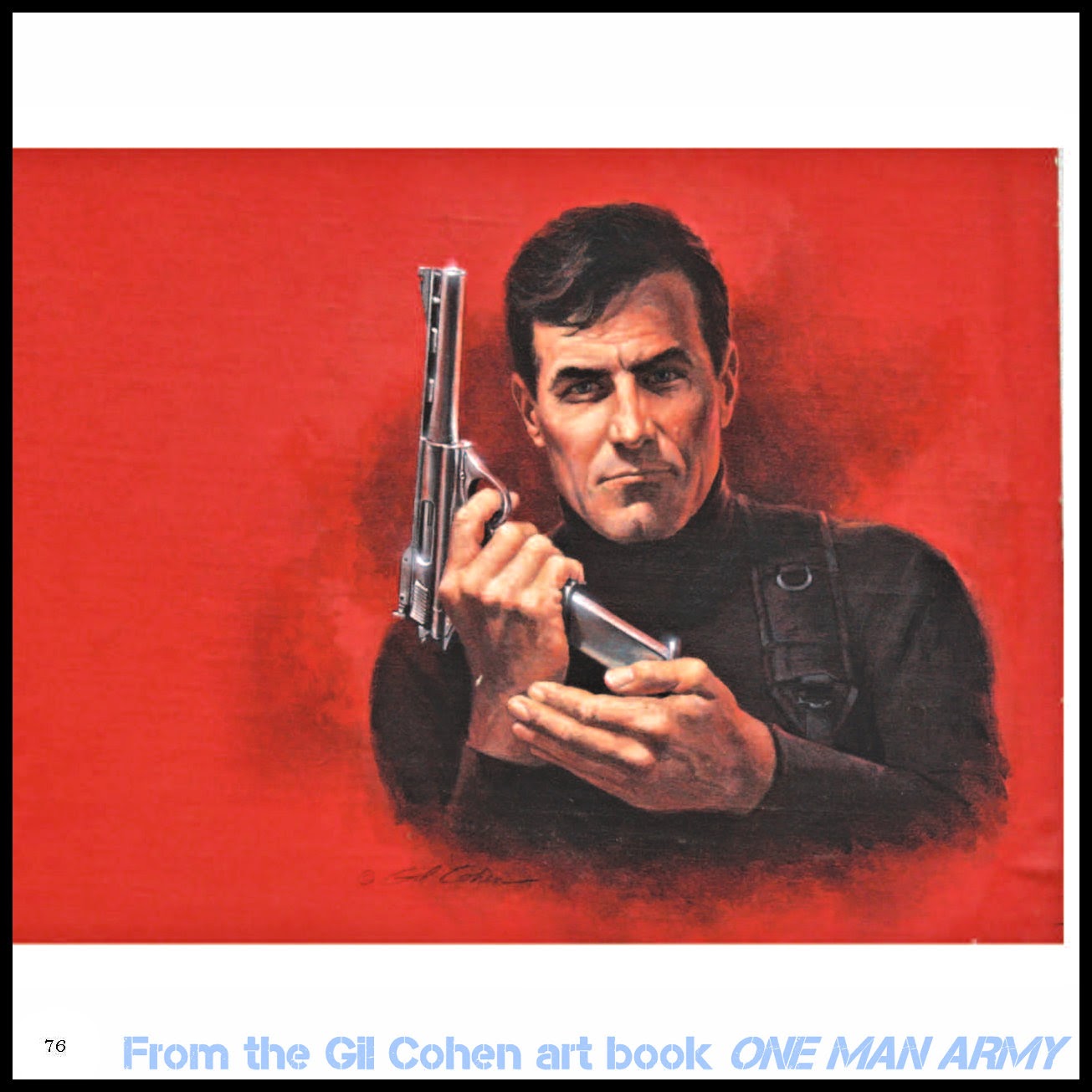
In the early 1980s, Gil started doing the cover paintings for Mack Bolan specials and spinoffs. Some of his own favorites are those he did for the Stony Man and SuperBolan novels. He told us that the image of Bolan he created for Stony Man #1, STONY MAN DOCTRINE (1983), is what he considers to be “the quintessential Bolan…in black with all of his accoutrements.” The page with that image is shown below, along with the pages featuring Gil’s original cover paintings for two SuperBolan novels, #4, DIRTY WAR (1985) and #9, TROPIC HEAT (1987).
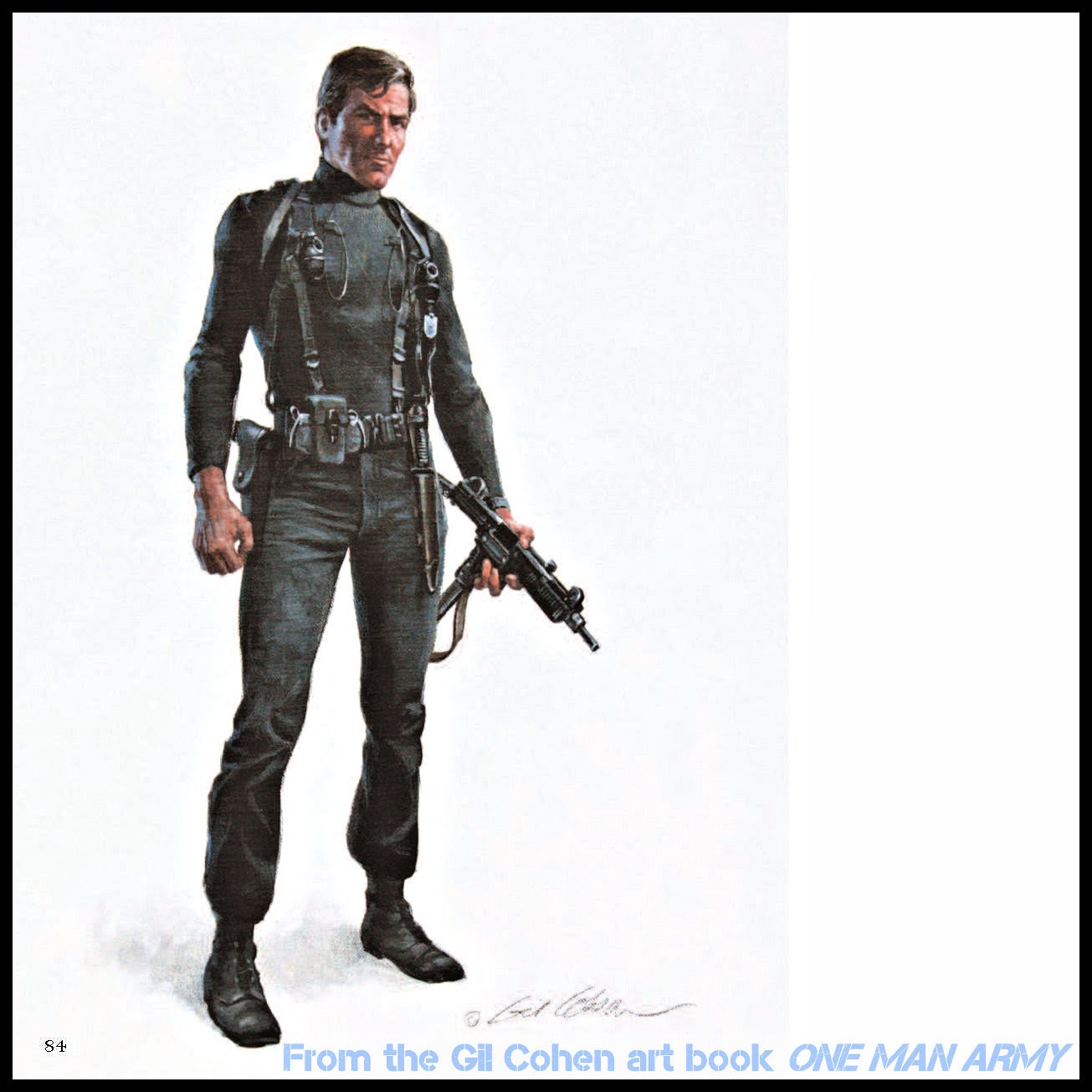
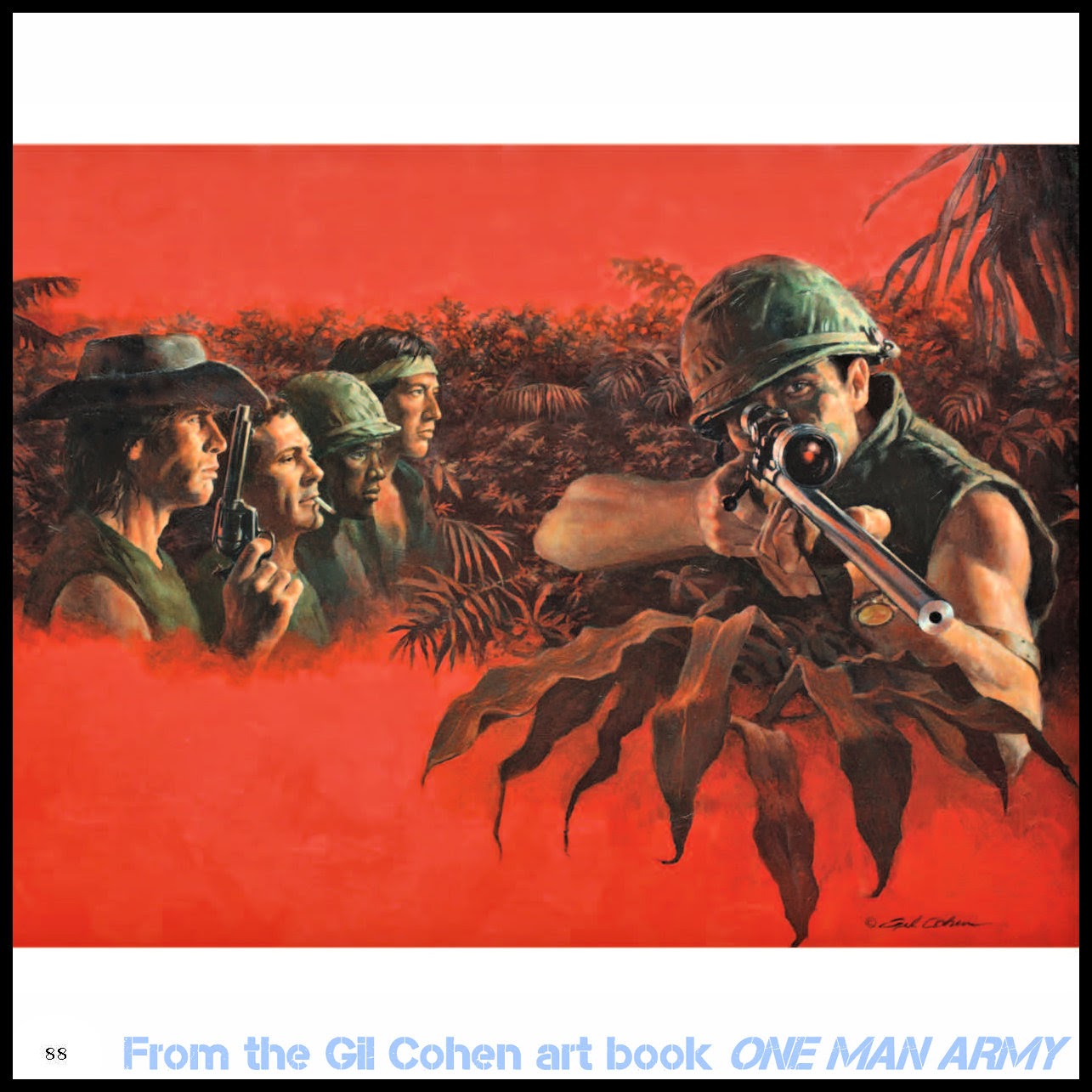
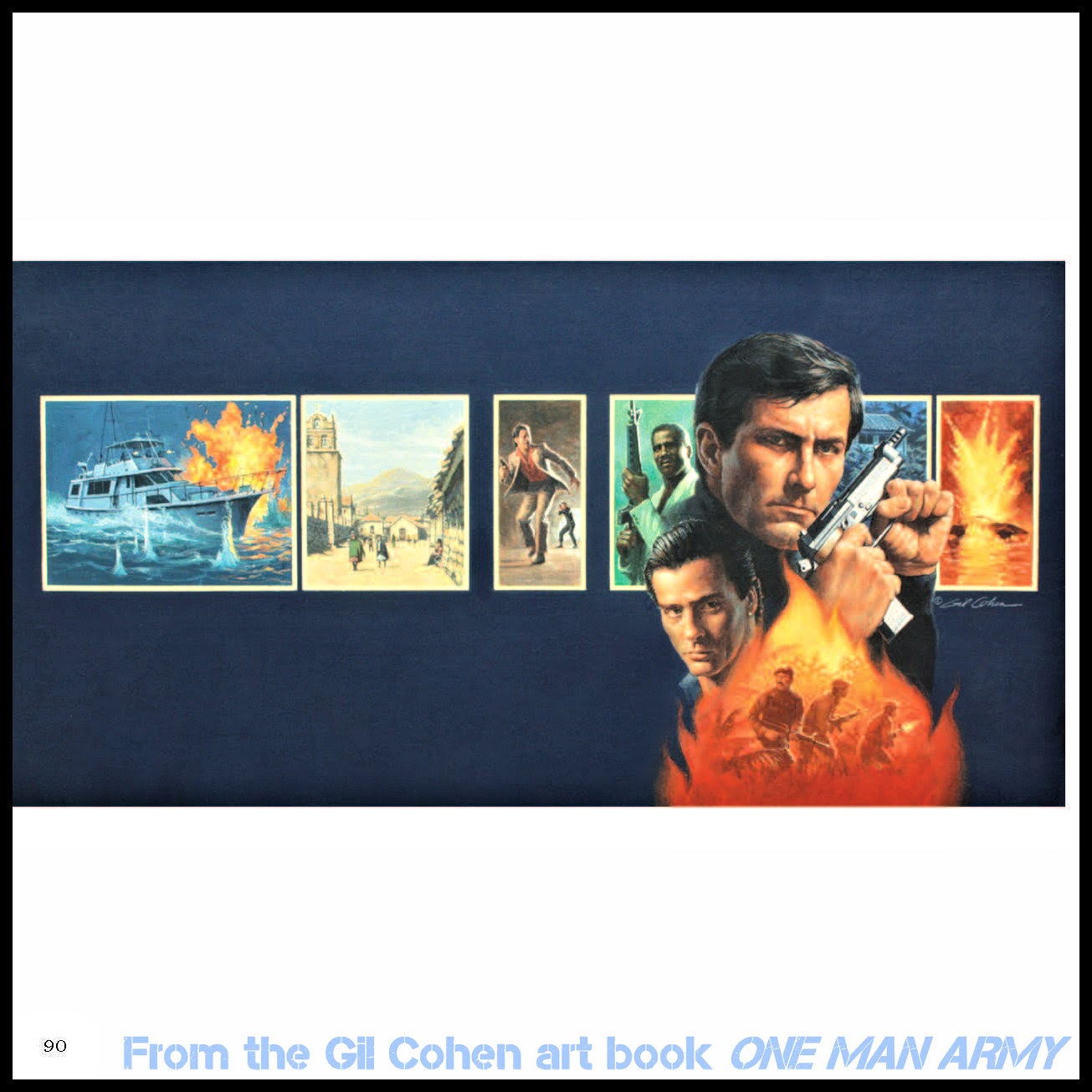
In the early 1980s, Harlequin’s Gold Eagle imprint launched two long-running Bolan spinoffs: the Able Team series, written by various authors under the House name Dick Stivers; and, the Phoenix Force series, credited under the House name Gar Wilson. Gil did the iconic early Able Team cover paintings that established the looks of the main characters in it, Carl Lyons, Rosario Blancanales, and Hermann Schwarz. Some of those shown in our book (and below) are Able Team #4, AMAZON SLAUGHTER (1983), #8, ARMY OF DEVILS (1983), and #12, DEATHBITES (1984).
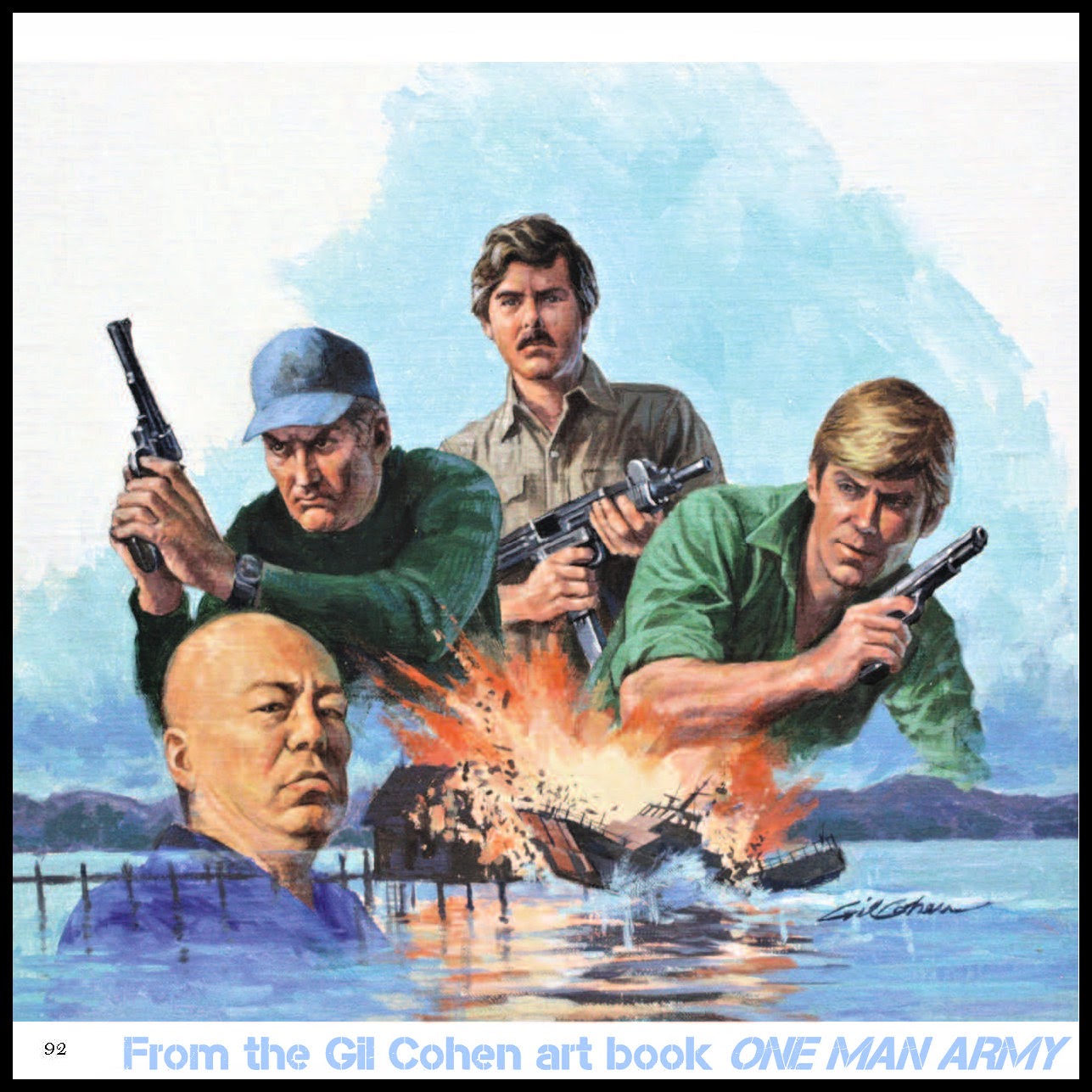
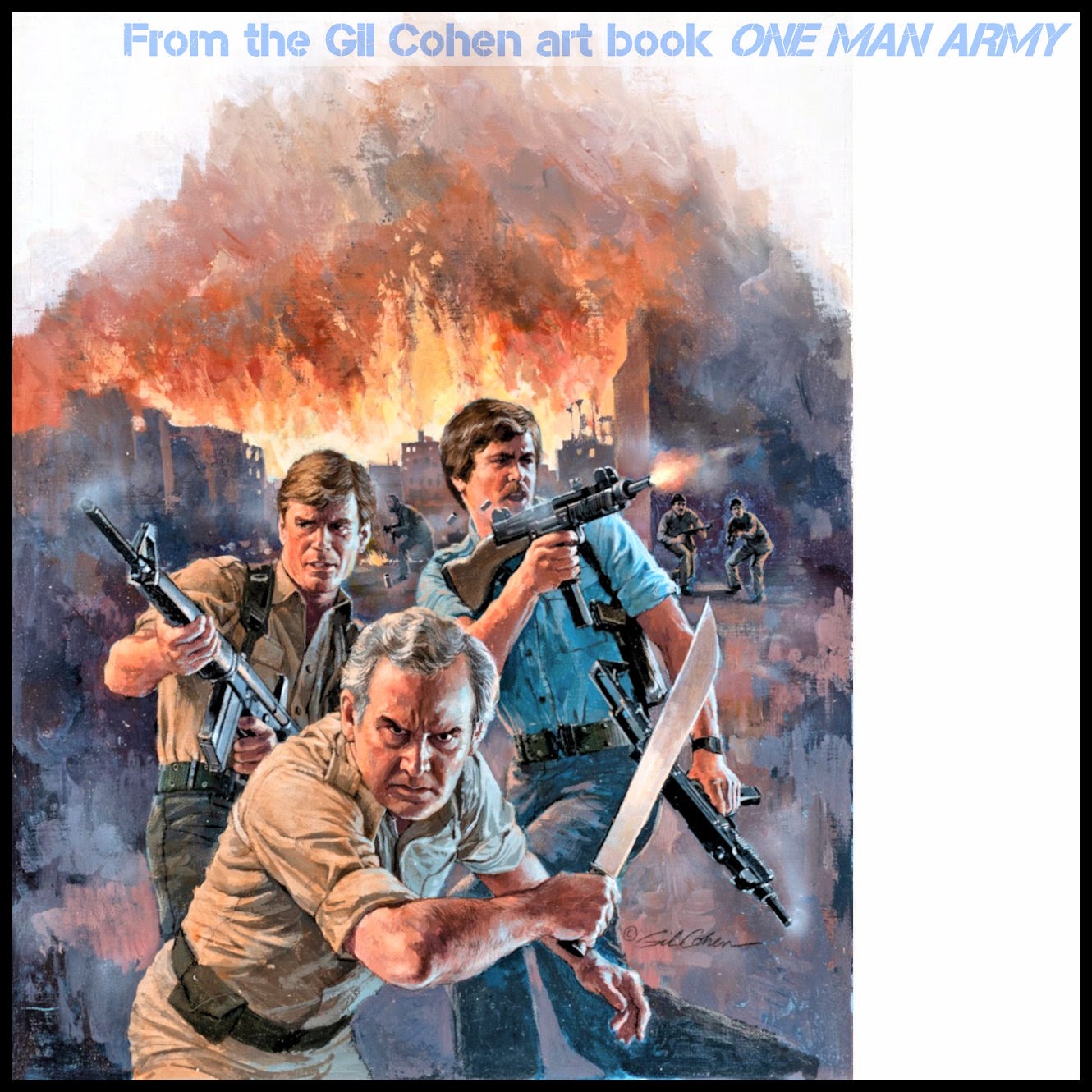
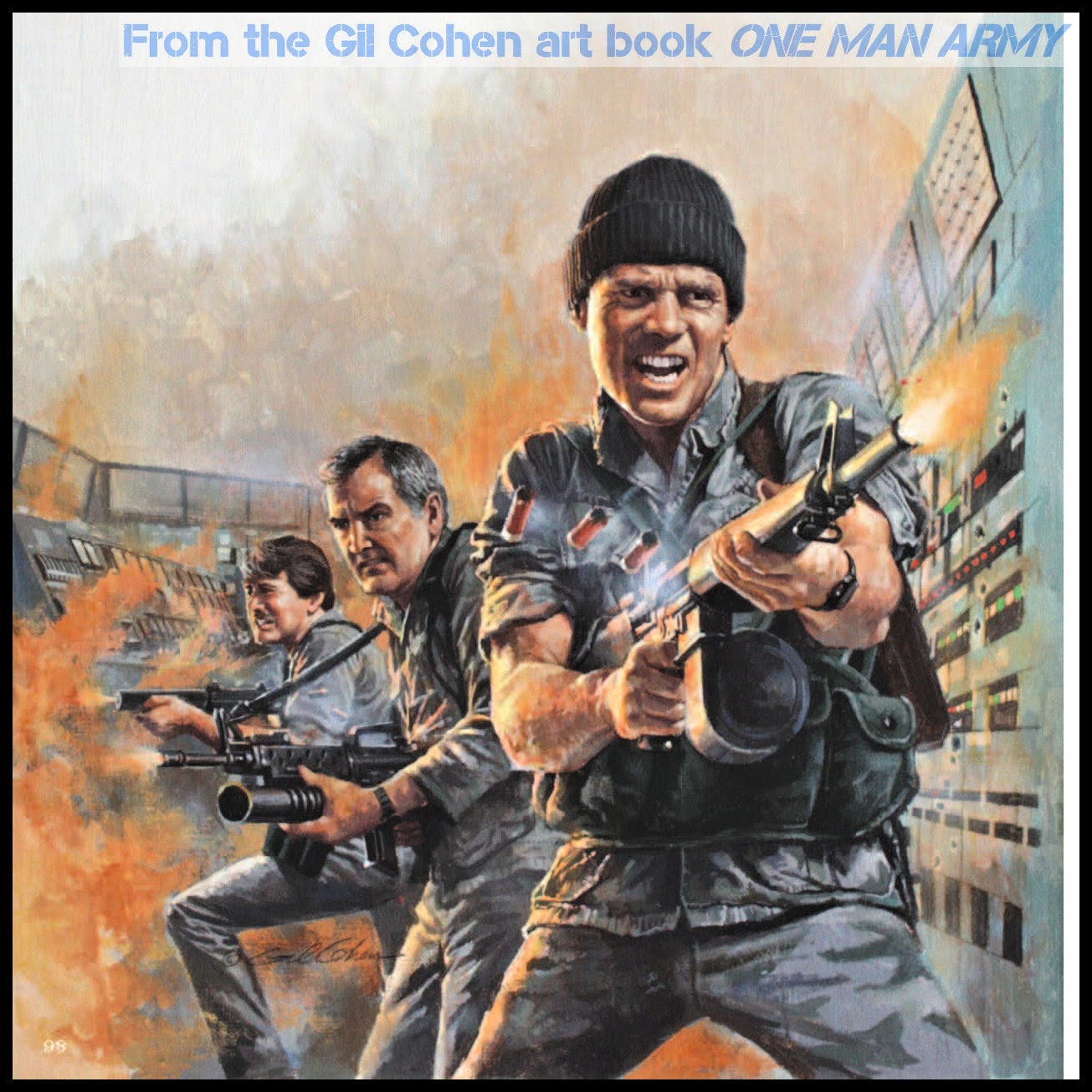
In his cover paintings for the Phoenix Force spinoff series, Gil again created the iconic images of the characters. They initially included, former Israeli commando Yakov Katzenelenbogen, Canadian demolitions expert Gary Manning, Japanese martial artist Keio Ohara, former SAS member David McCarter, and anti-Castor Cuban rebel Rafael Encizo. Later in the series, Ohara was killed. He was replaced by African-American Vietnam veteran Calvin James. And, when Katz retired, former Delta Force member T.J. Hawkins was added to the team.
“Phoenix Force, I did for a much longer time [than Able Team],” Gil recalled. “There were 58 Phoenix Force covers, from 1982 to 1992…So if my memory is correct, the covers during those years are all mine.”
Gil also noted that many of the Phoenix Force covers were wraparound covers. Thus, his cover paintings were created so the front and back cover art was all part of the same scene. Gil said, with a bit of understatement: “A panoramic cover of that type simply took more time to paint. They would have to, because there’s more involved.”
Some of the awesomely cool wraparound Phoenix Force cover paintings by Gil that are featured in our book are Phoenix Force #4, TIGERS OF JUSTICE (1983), #20, TOOTH AND CLAW (1985), and #29, THE NIGHTMARE MERCHANTS (1987).
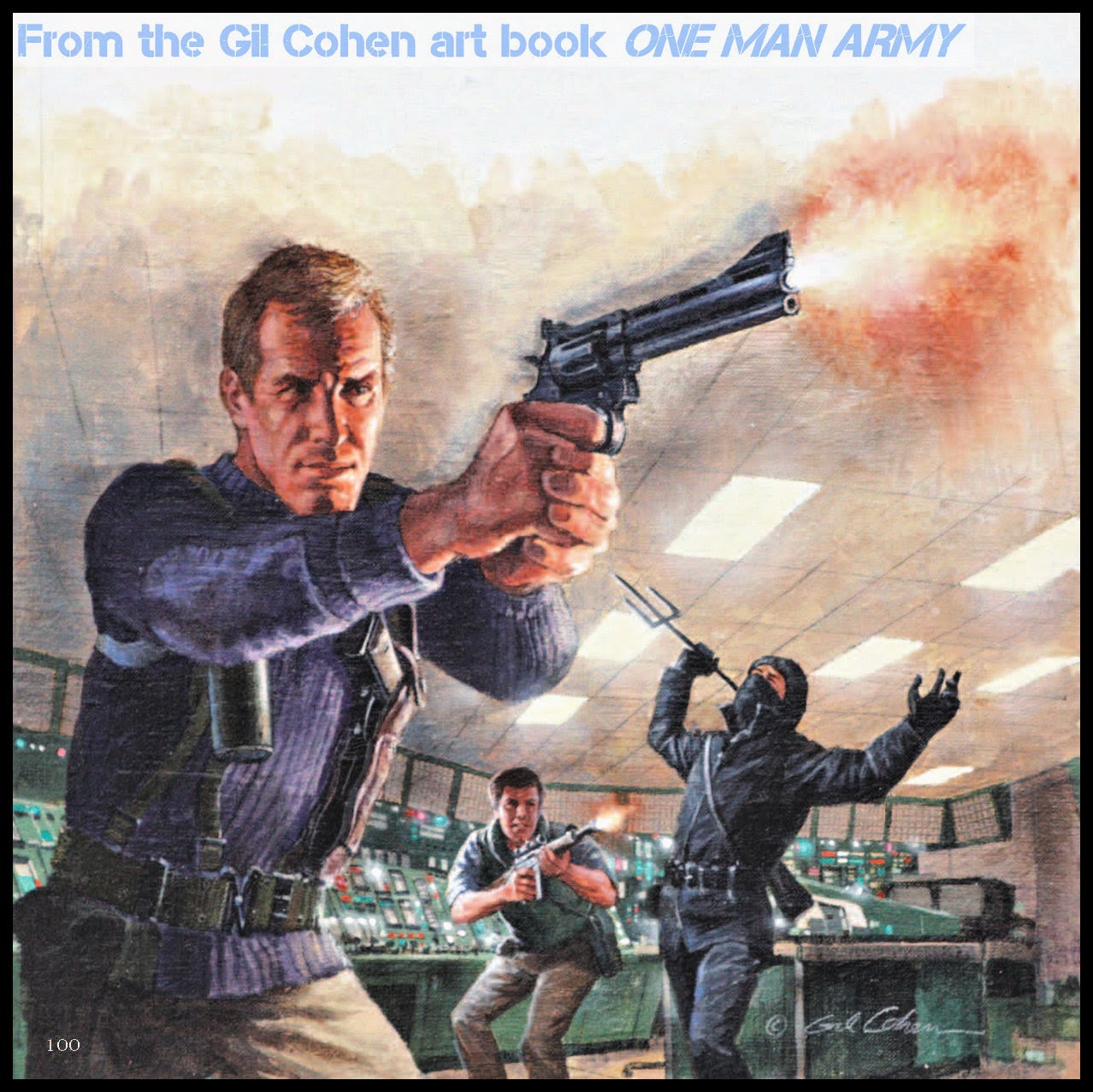
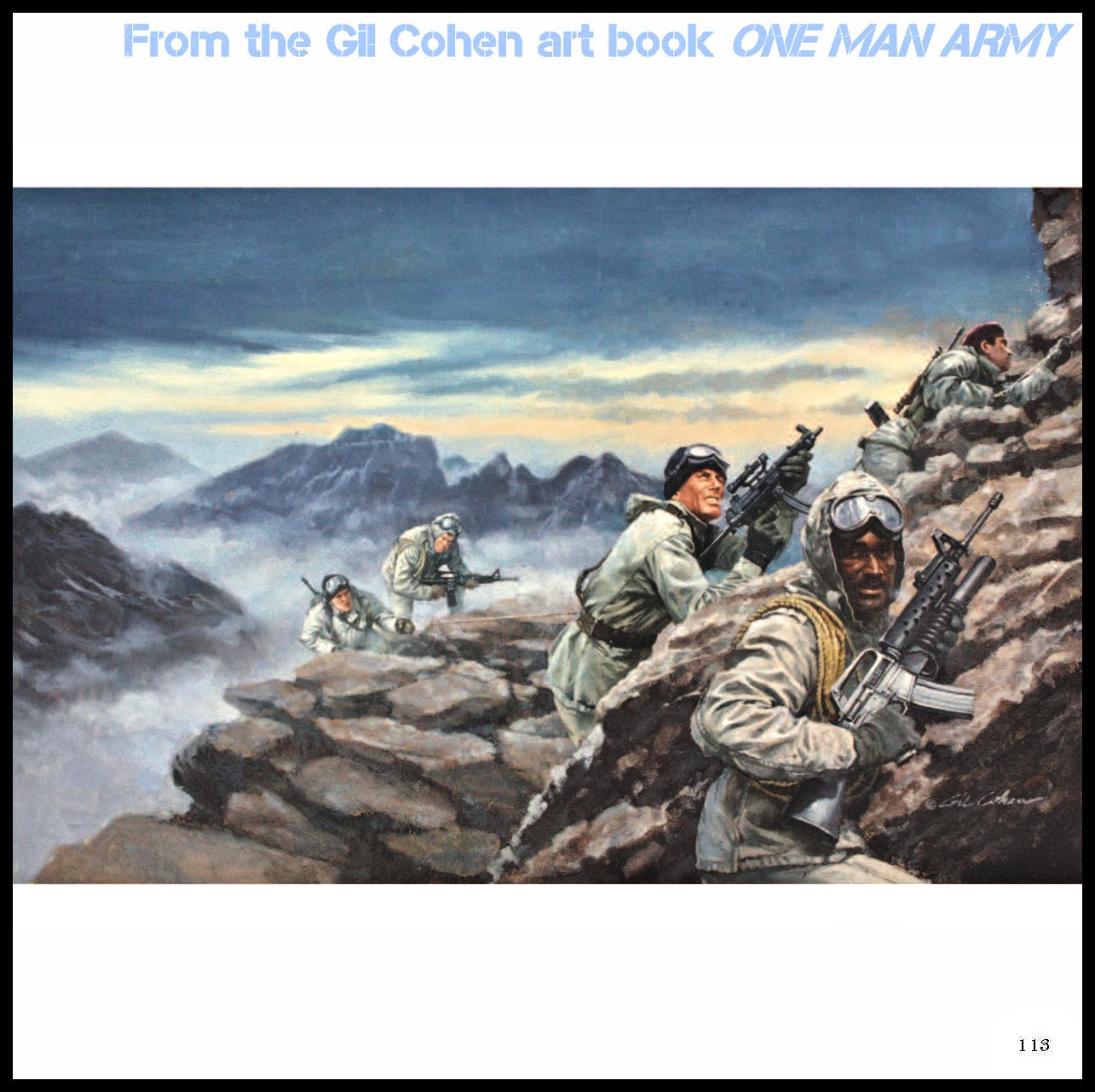
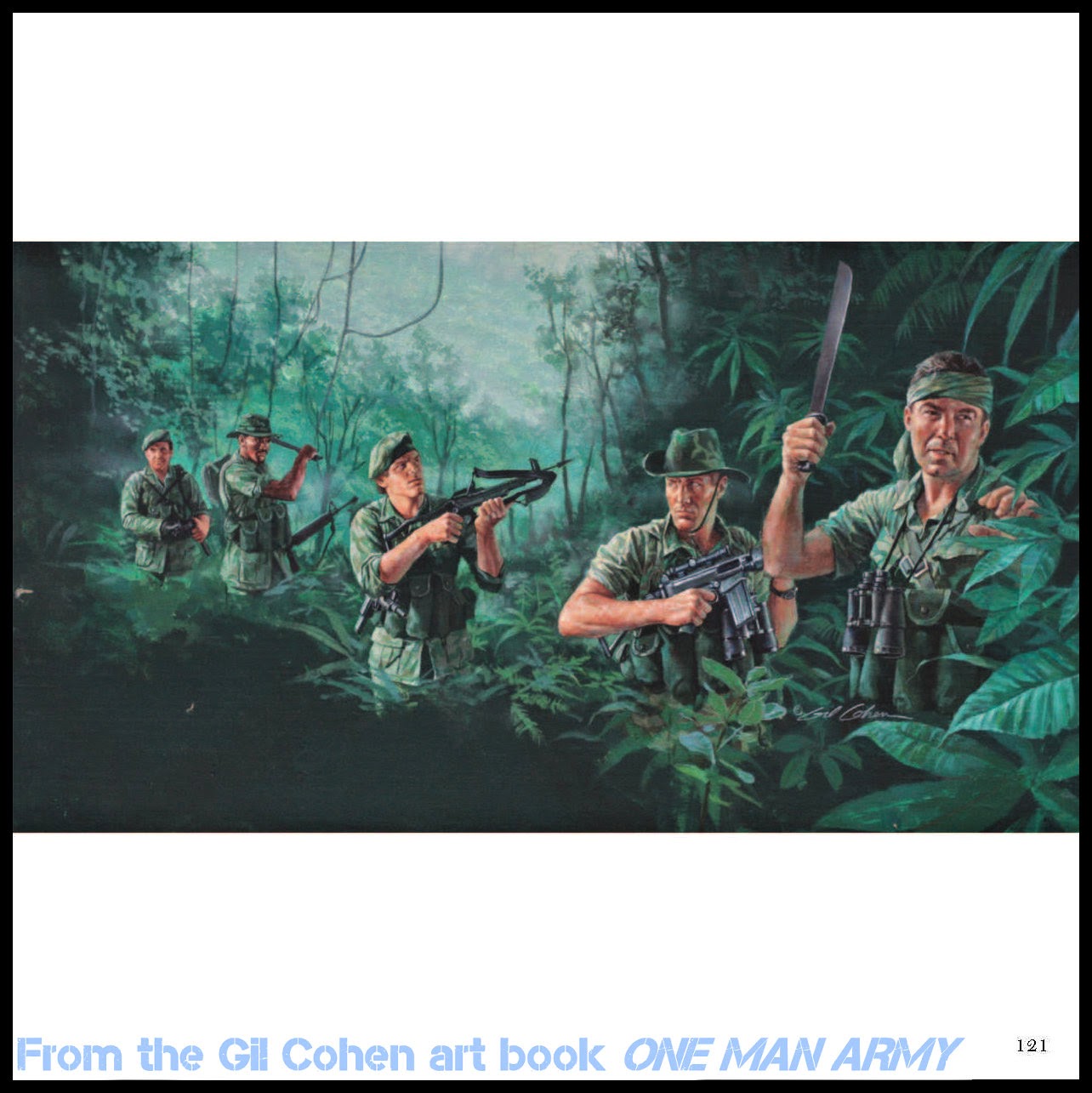
In the 1990s, Gil Cohen moved on from doing paperback covers and began another phase of career doing military aviation art, a phase that is still continuing. Many of the paintings from this phase of his career are showcased in the beautiful book GIL COHEN: AVIATION ARTIST.
“I started doing aviation art for galleries and commissions around 1990, and I take a lot more time with those,” Gil told us. “It can take me months to do an aviation painting. Of course, you can see the result; I think they’re even better. And I think I’m a better artist now, if I might say so, than I was when I was doing MAM and paperback artwork. But they were the training ground for all of it.”
Of course, I like and appreciate Gil’s military aviation paintings. I’ve even bought prints of some. But I am a particularly huge fan of the artwork he did for the covers of the Mack Bolan/Executioner novels and the other action/adventure series it spawned. Wyatt Doyle and I are proud to have been able to work with Gil to feature them in the book ONE MAN ARMY: THE ACTION PAPERBACK ARTWORK OF GIL COHEN.
Wyatt and I are also huge fans of the cover and interior paintings Gil did for men’s adventure magazines, during the first phase of his art career. I’m hoping a book featuring those will be one of the future art books in our Men’s Adventure Library series.
Comments? Corrections? Post them on the Weasels Ripped My Book Facebook Page, email them to me,
or join the Men’s Adventure Magazines & Books Facebook Group and post them there.
Related reading…


